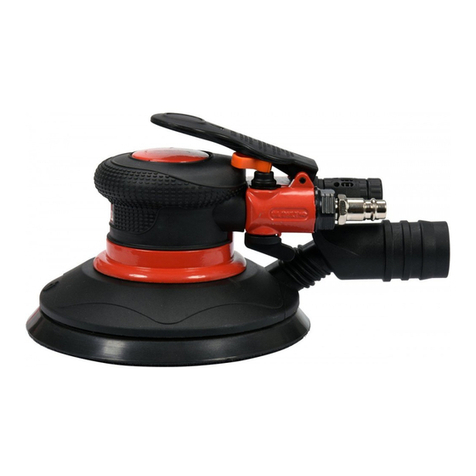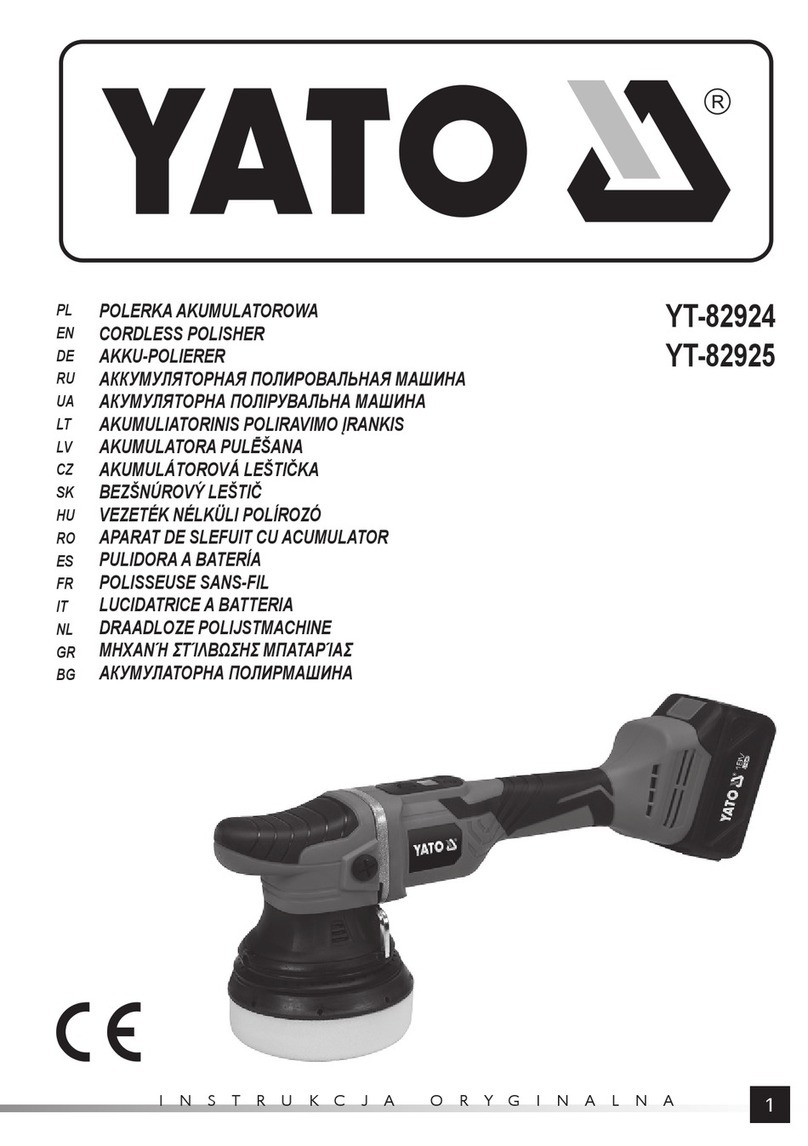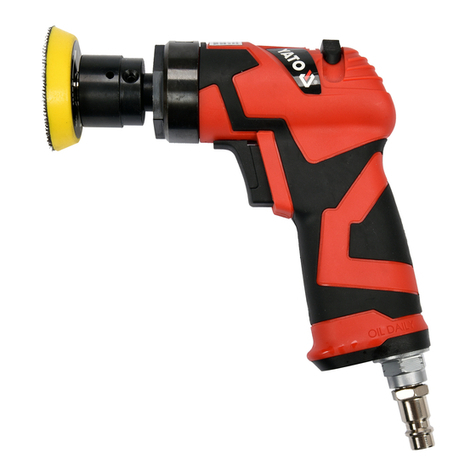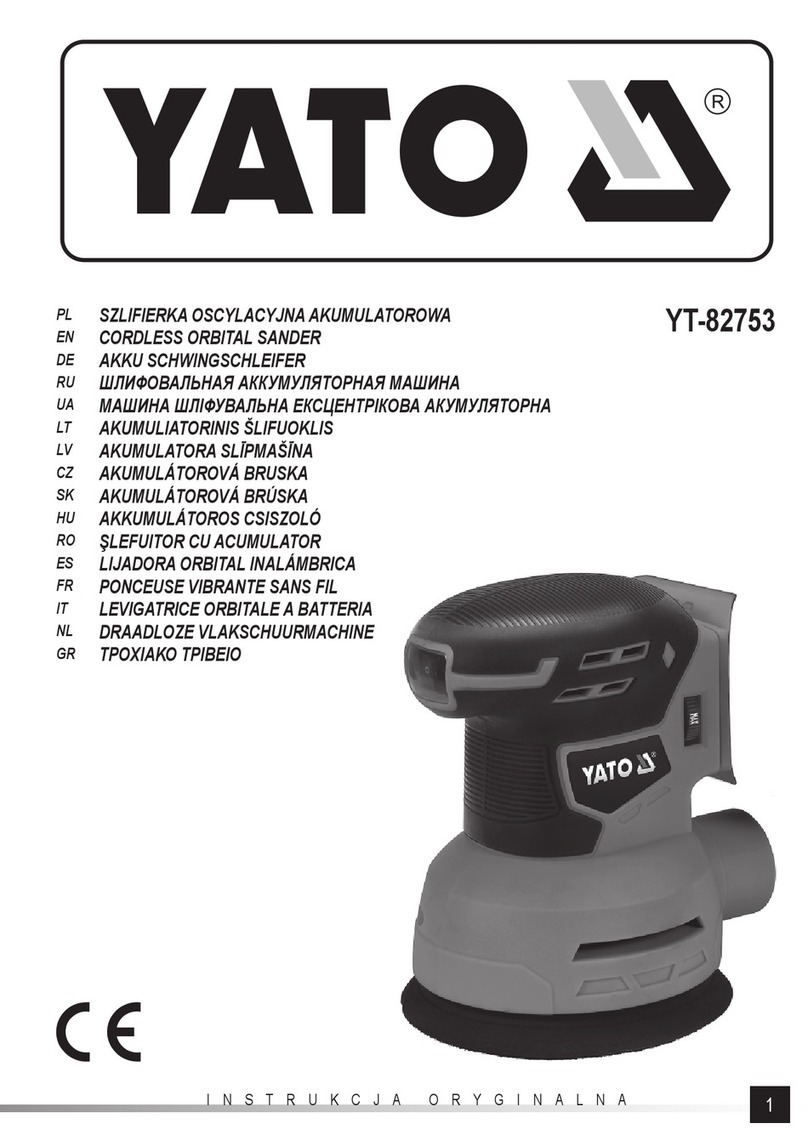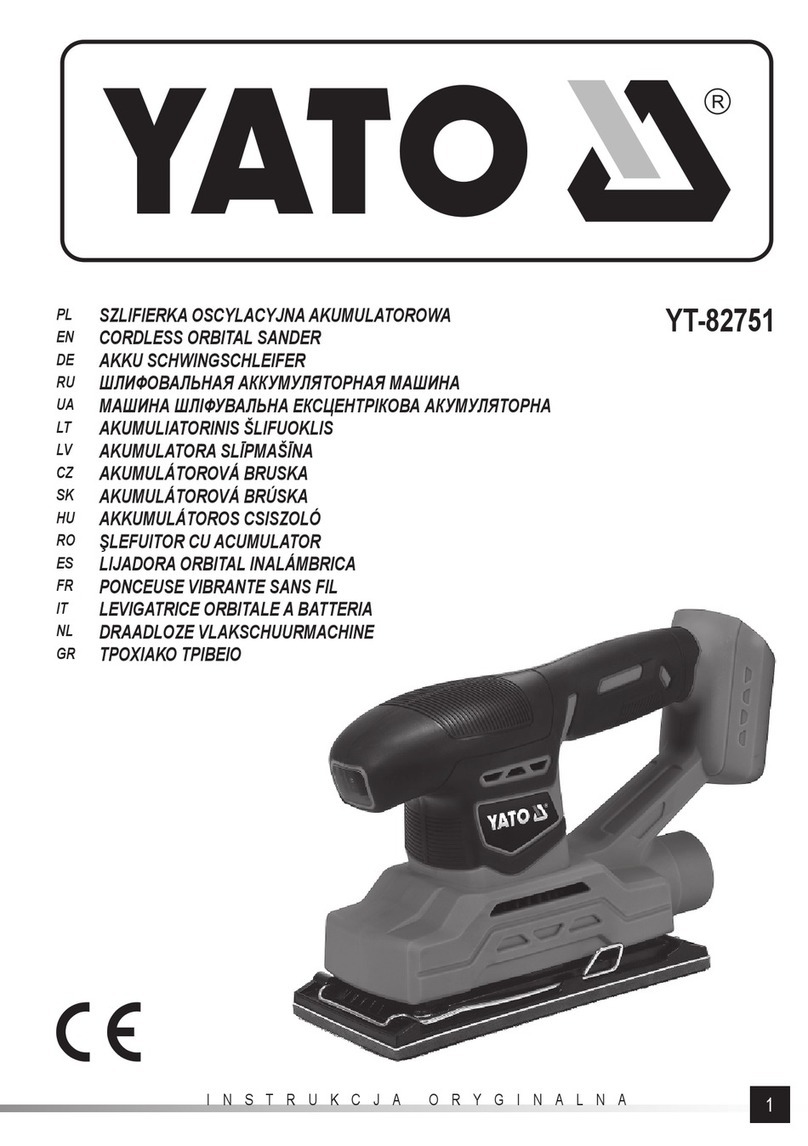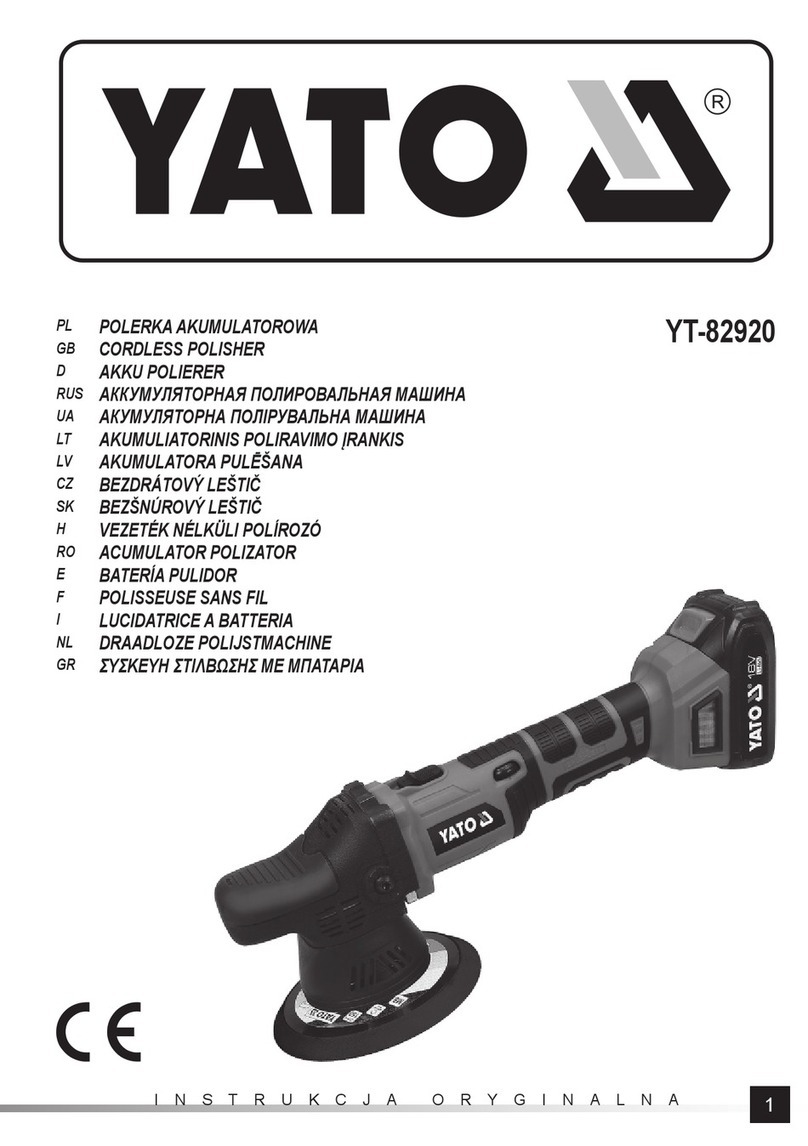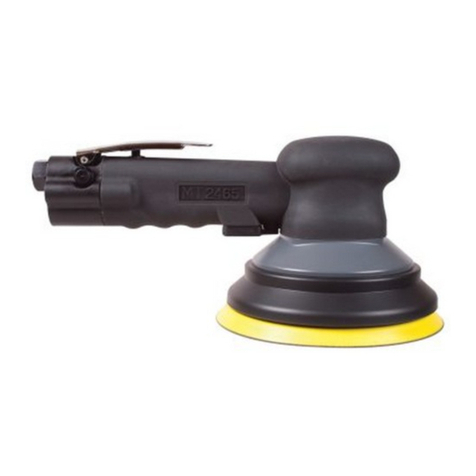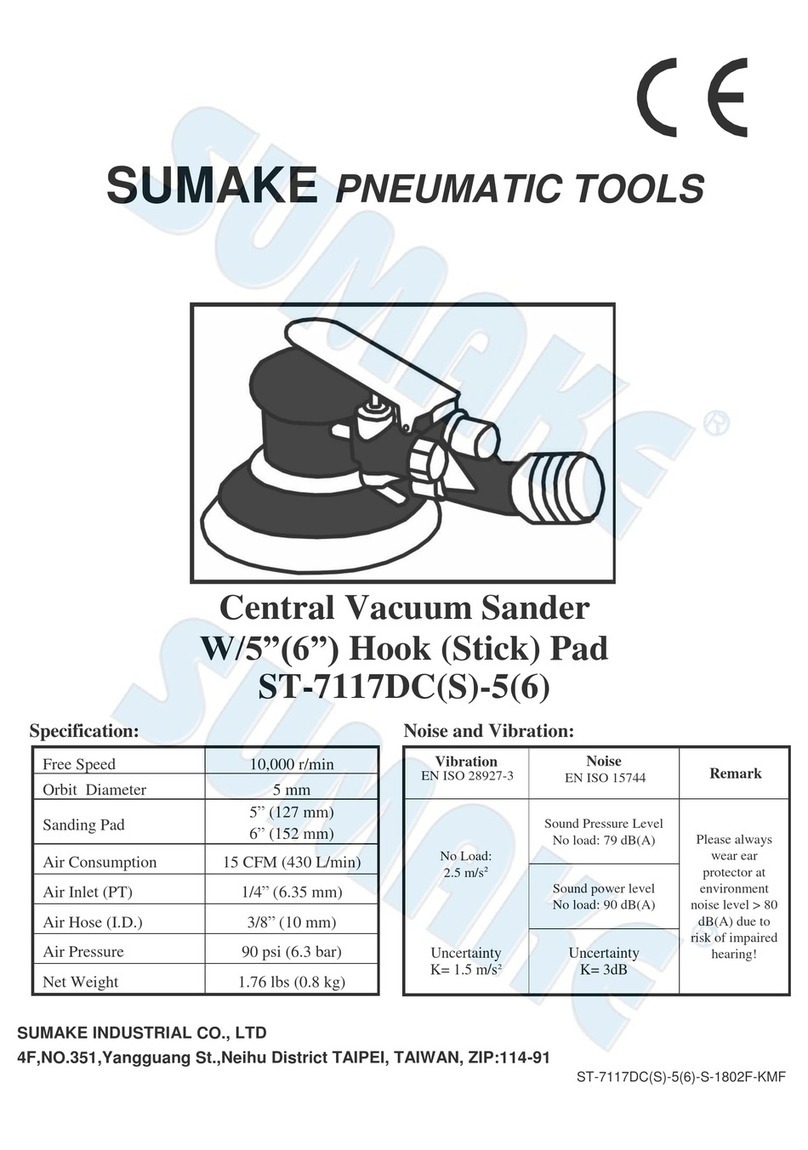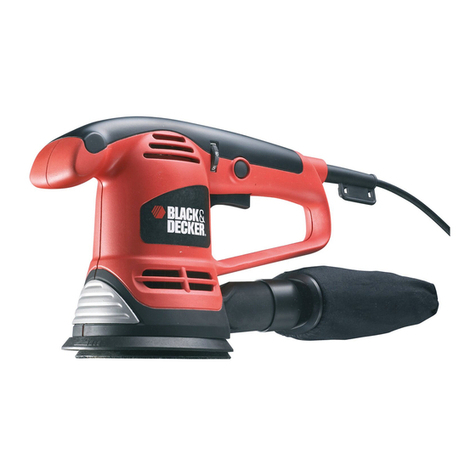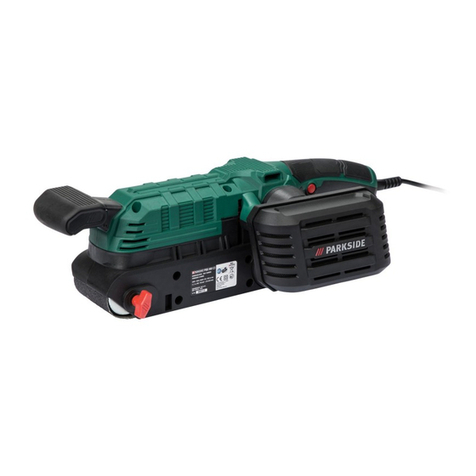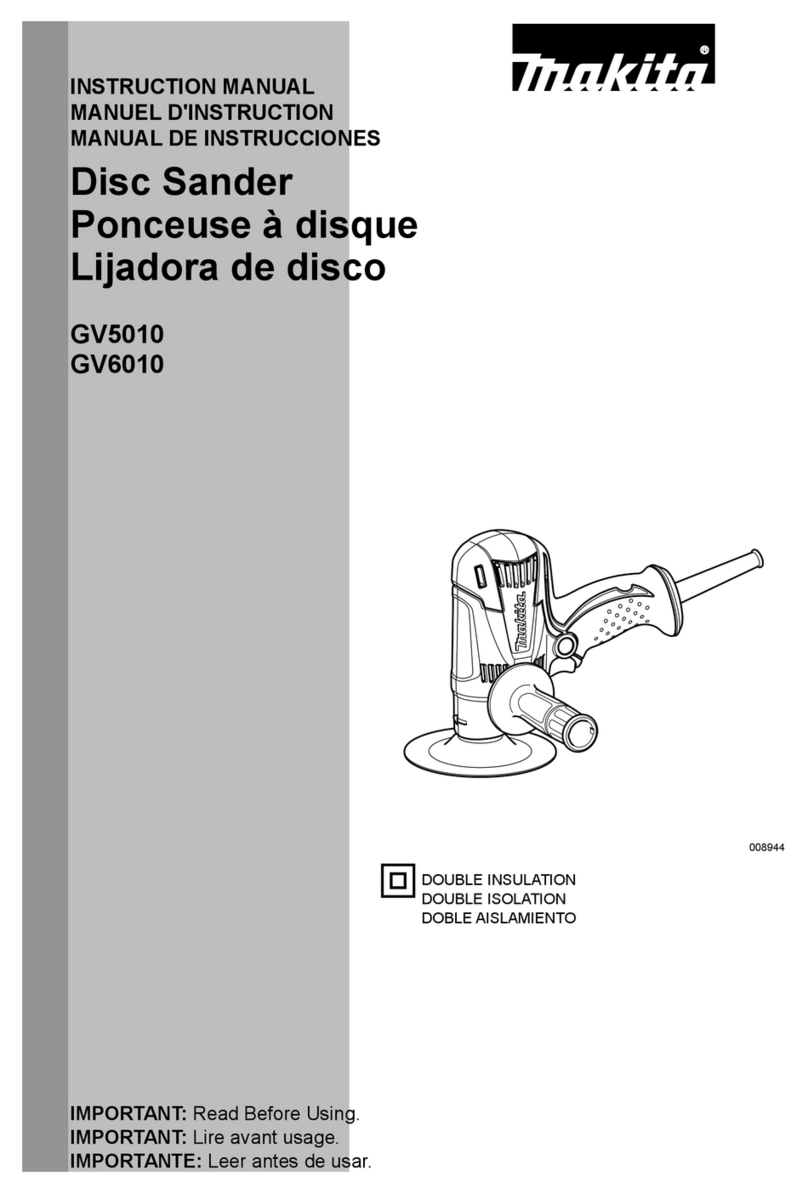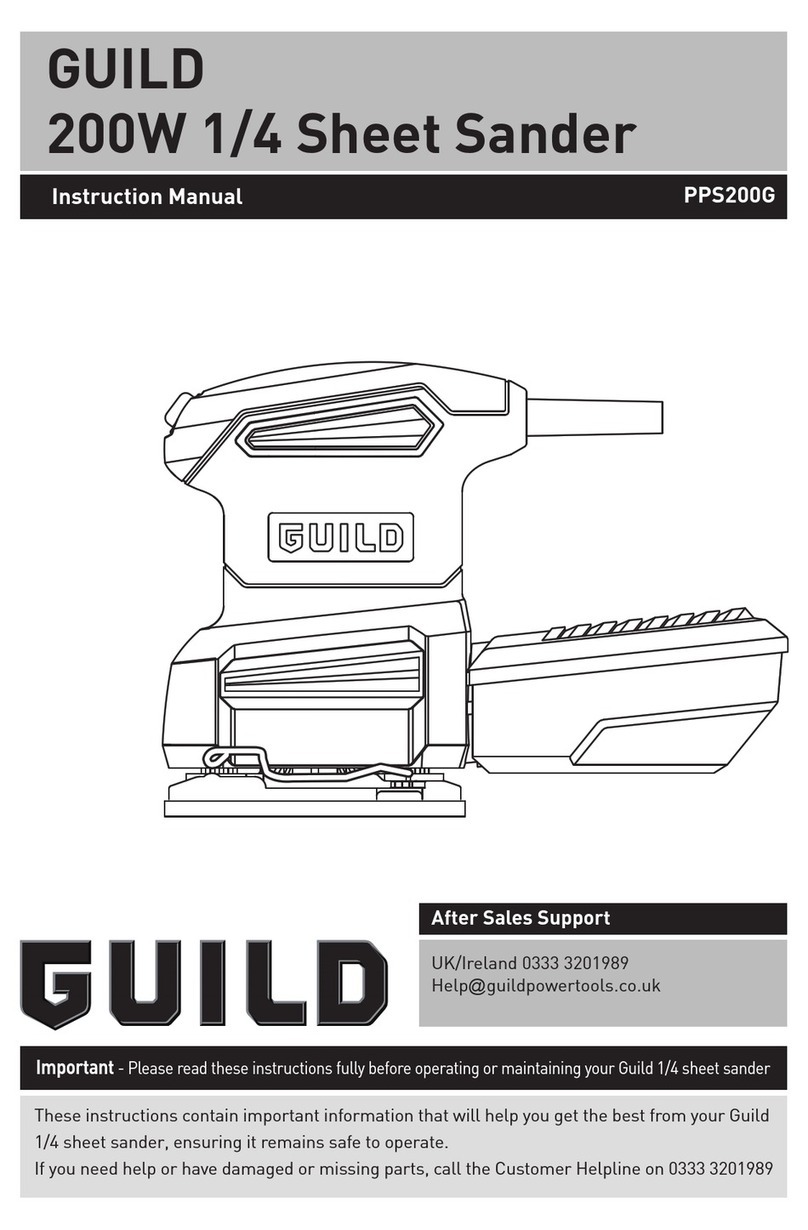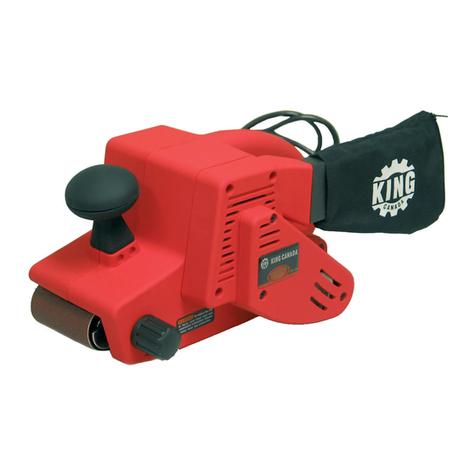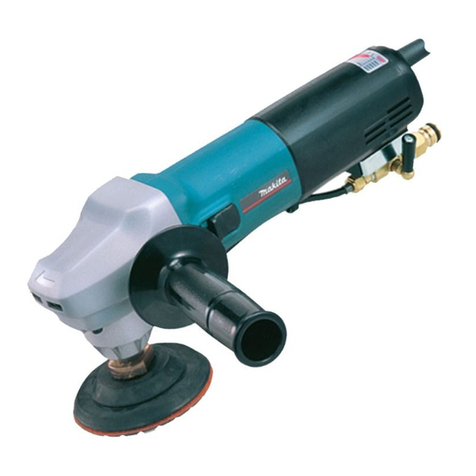YATO YT-09738 User manual

INSTRUKCJA ORYGINALNA 1
SZLIFIERKA PNEUMATYCZNA MIMOŚRODOWA
AIR SANDER
DRUCKLUFT- EXCENTERSCHLEIFER
ШЛИФМАШИНА ЭКСЦЕНТРИКОВАЯ ПНЕВМАТИЧЕСКАЯ
АПАРАТ ШЛIФУВАЛЬНИЙ
PNEUMATINIS ŠLIFUOTUVAS
PNEIMATISKĀSLĪPMAŠĪNA
BRUSKA PNEUMATICKÁ
BRÚSKA PNEUMATICKÁ
PNEUMATIKUS SAROKCSISZOLÓGÉP
MASINA DE SLEFUIT PNEUMATICA
LIJADORA NEUMÁTICA EXCENTRICA
PONCEUSE AIR
LEVIGATRICE ECCENTRICA PNEUMATICA
PNEUMATISCHE EXCENTERSCHUURMACHINE
ΕΚΚΕΝΤΡΟΣ ΛΕΙΑΝΤΗΡΑΣ ΑΕΡΟΣ
YT-09738
PL
EN
DE
RU
UA
LT
LV
CZ
SK
HU
RO
ES
FR
IT
NL
GR

INSTRUKCJA ORYGINALNA
2
PL EN DE RU UA LT LV CZ SK H RO ES FR IT NL GR
TOYA S.A. ul. Sołtysowicka 13-15, 51-168 Wrocław, Polska; www.yato.com
Rok produkcji:
Production year:
Produktionsjahr:
Год выпуска:
Рік випуску:
Pagaminimo metai:
Ražošanas gads:
Rok výroby:
Rok výroby:
2022 Gyártási év:
Anul producţiei utilajului:
Año de fabricación:
Année de fabrication:
Anno di produzione:
Bouwjaar:
Έτος παραγωγής:
I
IV
III
II
V
VI
4
5
3
2
1
7
8
6
9
12 10
11
13 14
15
16

INSTRUKCJA ORYGINALNA 3
PL EN DE RU UA LT LV CZ SK H RO ES FR IT NL GR
1. wlot powietrza
2. złączka wlotu powietrza
3. dźwignia włącznika
4. uchwyt narzędziowy
5. regulacja ciśnienia
6. tarcza szlifierska
7. króciec odciągu pyłu
8. klucz
9. narzędzie
10. gniazdo węża
11. wąż
12. złączka węża
13. smarownica
14. reduktor
15. filtr
16. kompresor
PL
1. Lufteintritt
2. Anschluss für Lufteintritt
3. Steuerschalterhebel
4. Werkzeughalter
5. Druckeinstellung
6. Schleifscheibe
7. Anschlussstutzen für Staubabsaugung
8. Schlüssel
9. Werkzeug
10. Druckluftschlauchanschluss
11. Druckluftschlauch
12. Druckluftschlauchstecker
13. Schmiervorrichtung
14. Reduzierventil
15. Luftfilter
16. Kompressor
DE
1. air Inlet
2. air inlet connector
3. switch lever
4. tool holder
5. pressure adjustment
6. grinding blade
7. dust extraction spigot
8. wrench
9. tool
10. hose socket
11. hose
12. hose connector
13. lubricator
14. reducer
15. filter
16. compressor
EN
1. входное отверстие воздуха
2. разъем спуска воздуха
3. рычаг выключателя
4. держатель инструмента
5. регулировка давления
6. шлифовальный диск
7. патрубок для удаления пыли
8. ключ
9. инструмент
10. гнездо шланга
11. шланг
12. муфта шланга
13. маслораспылитель
14. редуктор
15. фильтр
16. компрессор
RU
1. впуск повітря
2. роз’єм впуску повітря
3. важіль вимикача
4. тримач інструменту
5. регулювання тиску
6. шліфувальний диск
7. патрубок для видалення пилу
8. ключ
9. інструмент
10. гніздо шланга
11. шланг
12. муфта шланга
13. маслорозпилювач
14. редуктор
15. фільтр
16. компресор
UA
1. oro įleidimo anga
2. oro įleidimo jungtis
3. jungiklio svertas
4. įrankio rankena
5. slėgio reguliavimas
6. šlifavimo diskas
7. dulkiųištraukimo jungtis
8. raktas
9. įrankis
10. žarnos lizdas
11. žarna
12. žarnos jungtis
13. tepalinė
14. reduktorius
15. filtras
16. kompresorius
LT
1. gaisa ieeja
2. gaisa ieejas savienotājs
3. slēdža svira
4. instrumentu turētājs
5. spiediena regulēšana
6. slīpdisks
7. putekļu nosūkšanas sistēmas īscaurule
8. atslēga
9. instruments
10. šļūtenes ligzda
11. šļūtene
12. šļūtenes savienotājs
13. eļļotājs
14. reduktors
15. filtrs
16. kompresors
LV
1. přívod vzduchu
2. spojka přívodu vzduchu
3. páka spínače
4. držák přístroje
5. regulace tlaku
6. brusný kotouč
7. konektor pro odsávání prachu
8. klíč
9. zařízení
10. připojení hadice
11. hadice
12. konektor hadice
13. mazací lis
14. reduktor
15. filtr
16. kompresor
CZ
1. entrée d’air
2. connecteur d’entrée d’air
3. levier de marche / arrêt
4. porte-outil
5. réglage de vitesse
6. plateau abrasif
7. tuyau d’aspiration des poussières
8. clef
9. outil
10. douille du tuyau flexible
11. tuyau flexible
12. raccord du tuyau flexible
13. graisseur
14. réducteur
15. filtre
16. compresseur
FR
1. presa d’aria
2. raccordo della presa d’aria
3. leva dell’interruttore
4. portautensile
5. regolazione della pressione
6. platorello
7. raccordo di aspirazione della polvere
8. chiave
9. attrezzo
10. presa del tubo flessibile
11. tubo flessibile
12. raccordo del tubo flessibile
13. lubrificatore
14. riduttore
15. filtro
16. compressore
IT
1. luchtingang
2. luchtingangconnector
3. schakelaar
4. gereedschapshouder
5. drukregeling
6. schuurschijf
7. stofafzuigaansluiting
8. sleutel
9. gereedschap
10. slangaansluiting
11. slang
12. slangkoppelstuk
13. smeertoestel
14. reductor
15. filter
16. compressor
NL
1. prívod vzduchu
2. spojka prívodu vzduchu
3. páčka zapínača
4. držiak nástroja
5. regulácia tlaku
6. brúsny kotúč
7. príruba odsávania prachu
8. kľúč
9. nástroj
10. konektor hadice
11. hadica
12. spojka hadice
13. maznica
14. reduktor
15. filter
16. kompresor
SK
1. légbeömlőnyílás
2. légbeömlőcsatlakozó
3. kapcsolókar
4. szerszámbefogó
5. nyomásszabályozó
6. csiszolókorong
7. porelszívó csatlakozó
8. kulcs
9. szerszám
10. tömlőbemenet
11. tömlő
12. tömlőcsatlakozó
13. olajozó
14. reduktor
15. szűrő
16. kompresszor
H
1. intrare aer
2. conector intrare aer
3. pârghie comutator
4. suport accesoriu
5. reglarea presiunii
6. disc taler
7. conector de extragere a prafului
8. cheie
9. mașină
10. mufăfurtun
11. furtun
12. conector furtun
13. dispozitiv de lubrifiere
14. reductor
15. filtru
16. compresor
RO
1. entrada de aire
2. conector de entrada de aire
3. palanca del interruptor
4. portaherramientas
5. control de presión
6. muela abrasiva
7. tubo de evacuación de polvo
8. llave
9. herramienta
10. entrada para la manguera
11. manguera
12. conector de manguera
13. lubricador
14. reductor
15. filtro
16. compresor
ES
1. εισαγωγή αέρα
2. σύνδεση εισόδου αέρα
3. μοχλός διακόπτη
4. λαβή ανιχνευτή
5. ρύθμιση πίεσης
6. δίσκος λείανσης
7. κοντός σωλήνας απορρόφησης σκόνης
8. κλειδί
9. εργαλείο
10. υποδοχή σωλήνα
11. εύκαμπτος σωλήνας
12. σύνδεση σωλήνα
13. λιπαντική διάταξη
14. μειωτήρας
15. φίλτρο
16. συμπιεστής
GR

INSTRUKCJA ORYGINALNA
4
PL EN DE RU UA LT LV CZ SK H RO ES FR IT NL GR
Przeczytaćinstrukcję
Read the operating instruction
Bedienungsanleitung durchgelesen
Прочитать инструкцию
Прочитать iнструкцiю
Perskaityti instrukciją
Jālasa instrukciju
Přečtet návod k použití
Prečítaťnávod k obsluhe
Olvasni utasítást
Citeşti instrucţunile
Lea la instrucción
Lire les instructions d’utilisation
Leggere l’istruzione operativa
Lees de gebruiksaanwijzing
Διαβάστε τις οδηγίες λειτουργίας
Używaćgogle ochronne
Wear protective goggles
Schutzbrille tragen
Пользоваться защитными очками
Користуйтесь захисними окулярами
Vartok apsauginius akinius
Jālieto drošības brilles
Používej ochranné brýle
Používaj ochranné okuliare
Használjon védőszemüveget!
Intrebuinţeazăochelari de protejare
Use protectores del oído
Porter des lunettes de protection
Indossare occhiali protettivi
Draag beschermende bril
Φορέστε προστατευτικά γυαλιά
Używaćochrony słuchu
Wear hearing protectors
Gehörschutz tragen
Пользоваться средствами защиты слуха
Користуйтесь засобами захисту слуху
Vartoti ausines klausai apsaugoti
Jālieto dzirdes drošības līdzekļu
Používej chrániče sluchu
Používaj chrániče sluchu
Használjon fülvédőt!
Intrebuinţeazăantifoane
Use protectores de la vista
Porter des protecteurs auditifs
Indossare protezioni acustiche
Draag gehoorbeschermers
Φορέστε προστατευτικά ακοής
0.63
MPa(max.)
Maksymalne ciśnienie pracy
Maximum air pressure
Max. Betriebsdruck
Максимальное рабочее давление
Максимальний робочий тиск
Maksimalus darbinis slėgis
Maksimāls darba spiediens
Požadovaný průtok vzduchu
Maximálny pracovný tlak
Maximális üzemi nyomás
Presiunea maximăde lucru
Presión de trabajo máxima
Pression de service maximale
Pressione di lavoro massima
Maximale werkdruk
Μέγιστη πίεση εργασίας
STANDARD
Średnica przyłącza powietrza
Air connection diameter
Durchmesser des Luftanschlusses
Диаметр воздушного присоединителя
Діаметр повітряного зєднувача
Oro įvado diametras
Gaisa savienojuma diametrs
Průměr vzduchové přípojky
Priemer vzduchovej prípojky
A levegőcsatlakozásának átmérője
Diametrul de racordare cu aer
Diámetro del conector del aire
Diamètre du raccrod d’air
Diametro allacciamento aria
Diameter van de luchtaansluiting
Διάμετρος σύνδεσης αέρος

INSTRUKCJA ORYGINALNA 5
PL
CHARAKTERYSTYKA NARZĘDZIA
Szlifierka mimośrodowa pneumatyczna jest narzędziem zasilanym strumieniem sprężonego powietrza pod odpowiednim ciśnie-
niem. Tarcza szlifierki jest wyposażona w rzep pozwalający na przyczepienie krążków papieru lub płótna ściernego o różnej
ziarnistości i różnym przeznaczeniu. Szlifierka znajduje zastosowanie głównie przy pracach lakierniczych związanych z przy-
gotowaniem powierzchni do kolejnych etapów pokrywania lakierem. Prawidłowa, niezawodna i bezpieczna praca narzędzia jest
zależna od właściwej eksploatacji, dlatego:
Przed przystąpieniem do pracy z narzędziem należy przeczytaćcałą instrukcjęi zachowaćją.
Za wszelkie szkody i obrażenia powstałe w wyniku używania narzędzia niezgodnie z przeznaczeniem, nie przestrzegania prze-
pisów bezpieczeństwa i zaleceńniniejszej instrukcji, dostawca nie ponosi odpowiedzialności. Używanie narzędzia niezgodnie z
przeznaczeniem, powoduje także utratępraw użytkownika do gwarancji, a także z tytułu niezgodności z umową.
WYPOSAŻENIE
Szlifierka jest wyposażona w złączkępozwalającąprzyłączyćjądo układu pneumatycznego. Szlifierka jest wyposażona w tarczę
o średnicy 150 mm.
DANE TECHNICZNE
Parametr Jednostka miary Wartość
Numer katalogowy YT-09738
Masa [kg] 1,2
Średnica przyłącza powietrza (PT) [mm / ”] 6,3 / 1/4
Średnica węża doprowadzającego powietrze (wewnętrzna) [mm / ”] 10 / 3/8
Obroty [min-1] 12 000
Średnica uchwytu narzędziowego [mm] M8
Średnica tarczy [mm] 150
Maksymalne ciśnienie pracy [MPa] 0,63
Wymagany przepływ powietrza (przy 6,2 barach) [l/min] 128
Ciśnienie akustyczne (ISO 15744) [dB(A)] 91,0 ± 3,0
Moc akustyczna (ISO 15744) [dB(A)] 105,0 ± 4,0
Drgania (ISO 28927-3) [m/s2] 10,3 ± 1,2
OGÓLNE WARUNKI BEZPIECZEŃSTWA
OSTRZEŻENIE! Podczas pracy narzędziem pneumatycznym zaleca sięzawsze przestrzegaćpodstawowych zasad bezpieczeń-
stwa pracy, łącznie z podanymi niżej, w celu ograniczenia zagrożenia pożarem, porażenia prądem elektrycznym oraz uniknięcia
obrażeń.
Przed przystąpieniem do eksploatacji niniejszego narzędzia przeczytaćcałą instrukcjęi zachowaćją.
UWAGA! Przeczytaćwszystkie poniższe instrukcje. Nieprzestrzeganie ich może prowadzićdo porażenia elektrycznego, pożaru
albo do uszkodzeńciała. Pojęcie „narzędzie pneumatyczne” użyte w instrukcjach odnosi siędo wszystkich narzędzi napędzanych
sprężonym strumieniem powietrza pod odpowiednim ciśnieniem.
PRZESTRZEGAĆPONIŻSZE INSTRUKCJE
Ogólne zasady bezpieczeństwa
Przed rozpoczęciem instalacji, pracy, naprawy, konserwacji oraz zmiany akcesoriów lub w przypadku pracy w pobliżu narzędzia
pneumatycznego z powodu wielu zagrożeń, należy przeczytaći zrozumiećinstrukcje bezpieczeństwa. Nie wykonanie powyż-
szych czynności może skutkowaćpoważnymi obrażeniami ciała. Instalacja, regulacja i montażnarzędzi pneumatycznych może
byćwykonywany tylko przez wykwalifikowany i wyszkolony personel. Nie modyfikowaćnarzędzia pneumatycznego. Modyfikacje
mogązmniejszyćefektywność oraz poziom bezpieczeństwa oraz zwiększyćryzyko operatora narzędzia. Nie wyrzucaćinstrukcji
bezpieczeństwa, należy je przekazaćoperatorowi narzędzia. Nie używaćnarzędzia pneumatycznego, jeżeli jest uszkodzone. Na-
rzędzie należy poddawaćokresowej inspekcji pod kątem widoczności danych wymaganych normąISO 11148. Pracodawca/ użyt-
kownik powinien skontaktowaćsięz producentem w celu wymiany tabliczki znamionowej za każdym razem gdy jest to konieczne.
Zagrożenia związane z wyrzucanymi częściami
Uszkodzenie obrabianego przedmiotu, akcesoriów lub nawet narzędzia wstawianego może spowodowaćwyrzucenie części z

INSTRUKCJA ORYGINALNA
6
PL
dużą prędkością. Zawsze należy stosowaćochronęoczu odpornąna uderzenia. Stopieńochrony należy dobieraćw zależności
od wykonywanej pracy. Należy sięupewnić, ze obrabiany przedmiot jest bezpiecznie zamocowany. W przypadku pracy narzę-
dziem nad głową, stosowaćhełm ochronny. Należy równieżbraćpod uwagęryzyko wobec osób postronnych.
Zagrożenia związane z zaplątaniem
Zagrożenie związane z zaplątaniem może spowodowaćzadławienie, oskalpowanie i/ lub skaleczenie w przypadku gdy luźna
odzież, biżuteria, włosy lub rękawice nie sątrzymane z dala od narzędzia lub akcesoriów.
Zagrożenia związane z pracą
Użytkowanie narzędzia może wystawićręce operatora na zagrożenia, takie jak: zmiażdżenie, uderzenie, odcięcie, ścieranie oraz
gorąco. Należy ubieraćwłaściwe rękawice do ochrony rąk. Operator oraz personel konserwujący powinni byćfizycznie zdolni do
poradzenia sobie z ilością, masąoraz mocąnarzędzia. Trzymaćnarzędzie poprawnie. Zachowaćgotowość do przeciwstawienia
sięnormalnym lub niespodziewanym ruchom oraz zachowaćdo dyspozycji zawsze obie ręce. Zachowaćrównowagęoraz za-
pewniające bezpieczeństwo ustawienie stóp. Należy zwolnićnacisk na urządzenie startu i stopu w przypadku przerwy w dostawie
energii zasilającej. Używaćtylko środków smarnych zalecanych przez producenta. Należy stosowaćokulary ochronne, zalecane
jest stosowanie dopasowanych rękawic oraz stroju ochronnego. Sprawdzićtarczępolerskąprzed każdym użytkiem. Nie stosować
tarcz pękniętych lub połamanych, lub tarcz, które zostały upuszczone. Unikaćbezpośredniego kontaktu z poruszającąsiętarczą
polerską, zapobiegnie to zaciśnięciu lub przecięciu rak bądźinnych części ciała. Stosowaćdopasowane rękawice do ochrony
rąk. Nigdy nie uruchamiaćnarzędzia, jeżeli nie zostałzaaplikowany środek ścierny na obrabiany materiał. Podczas pracy na ele-
mentach plastikowych lub nieprzewodzących istnieje ryzyko wyładowania elektrostatycznego. Polerowanie lub szlifowanie może
powodowaćpowstawanie pyłów i oparów, które mogąstworzyćatmosferęzagrożenia wybuchem. Zawsze stosowaćsystemy
pochłaniania lub odprowadzania pyłu, które sąwłaściwe do obrabianego materiału.
Zagrożenia związane z powtarzalnymi ruchami
Podczas stosowania narzędzia pneumatycznego do pracy polegającej na powtarzaniu ruchów, operator jest narażony na do-
świadczenie dyskomfortu dłoni, ramion, barków, szyi lub innych części ciała. W przypadku użytkowania narzędzia pneumatycz-
nego, operator powinien przyjąć komfortowąpostawęzapewniającąwłaściwe ustawienie stóp oraz unikaćdziwnych lub nie
zapewniających równowagi postaw. Operator powinien zmieniaćpostawępodczas długiej pracy, pomoże to uniknąć dyskomfortu
oraz zmęczenia. Jeżeli operator doświadcza symptomów takich jak: trwały lub powtarzający siędyskomfort, ból, pulsujący ból,
mrowienie, drętwienie, pieczenie lub sztywność. Nie powinien ich ignorować, powinien powiedziećo tym pracodawcy i skonsul-
towaćsięz lekarzem.
Zagrożenia związane z akcesoriami
Odłączyćnarzędzie od źródła zasilania przed zmianąnarzędzia wstawionego lub akcesoria.
Unikaćbezpośredniego kontaktu z narzędziem wstawianym podczas oraz po pracy, może byćgorące lub ostre. Stosowaćak-
cesoria i materiały eksploatacyjne tylko w rozmiarach i typach, które sązalecane przez producenta. Nie stosowaćakcesoriów
innego typu lub innego rozmiaru. Nie stosowaćściernic do szlifowania lub cięcia. Sprawdzićczy maksymalna prędkość pracy na-
rzędzia wstawianego (ściernice listkowe, pasy ścierne, dyski z włóknami, tarcze polerskie) jest większa niżprędkość znamionowa
szlifierki lub polerki. Samomocujące dyski polerujące powinny byćmocowane koncentrycznie na tarczy polerskiej.
Zagrożenia związane z miejscem pracy
Poślizgnięcia, potknięcia i upadki sągłównymi przyczynami obrażeń. Wystrzegaćsię, śliskich powierzchni spowodowanych użyt-
kowaniem narzędzia, a także zagrożeńpotknięciem spowodowanym instalacjąpowietrzną. Postępowaćostrożnie w nieznanym
otoczeniu. Mogąistniećukryte zagrożenia, takie jak elektryczność lub inne linii użytkowe. Narzędzie pneumatyczne nie jest
przeznaczone do stosowania w strefach zagrożonych wybuchem i nie jest izolowane od kontaktu z energiąelektryczną. Upewnić
się, że nie istniejążadne przewody elektryczne, rury gazowe, itp., które mogąpowodowaćzagrożenie w przypadku uszkodzenia
przy użyciu narzędzia.
Zagrożenia związane z oparami i pyłami
Pyłi opary powstałe przy użyciu narzędzia pneumatycznego mogąspowodowaćzły stan zdrowia (na przykład raka, wady wro-
dzone, astma i/ lub zapalenie skóry), niezbędne są: ocena ryzyka i wdrożenie odpowiednich środków kontroli w odniesieniu do
tych zagrożeń. Ocena ryzyka powinna zawieraćwpływ pyłu utworzonego przy użyciu narzędzia i możliwość wzburzenia istnieją-
cego pyłu. Obsługęi konserwacjęnarzędzia pneumatycznego należy przeprowadzaćwedług zaleceńinstrukcji obsługi, pozwoli
zminimalizowaćemisjęoparów i pyłu. Wylot powietrza należy tak kierować, aby zminimalizowaćwzbudzanie pyłu w zakurzonym
środowisku. Tam gdzie powstająpyłlub opary, priorytetem powinna byćkontrola ich w źródle emisji. Wszystkie zintegrowane
funkcje i wyposażenie do zbierania, ekstrakcji lub zmniejszenia pyłu lub dymu powinny byćprawidłowo użytkowane i utrzymy-
wane zgodnie z zaleceniami producenta. Wybierać, konserwowaći wymieniaćnarzędzia wstawiane według zaleceńinstrukcji,
aby zapobiec wzrostowi oparów i pyłu. Używaćochrony dróg oddechowych, zgodnie z instrukcjami pracodawcy oraz zgodnie z
wymogami higieny i bezpieczeństwa.

INSTRUKCJA ORYGINALNA 7
PL
Zagrożenie hałasem
Narażenie, bez zabezpieczeń, na wysoki poziom hałasu może spowodowaćtrwałą i nieodwracalnąutratęsłuchu oraz inne pro-
blemy, takie jak szum w uszach (dzwonienie, brzęczenie, gwizdanie lub buczenie w uszach). Niezbędna jest ocena ryzyka oraz
wdrożenie odpowiednich środków kontroli w odniesieniu do tych zagrożeń. Odpowiednie kontrole w celu zmniejszenia ryzyka
mogąobejmowaćdziałania takie jak: materiały tłumiące zapobiegające „dzwonieniu” obrabianego przedmiotu. Używaćochrony
słuchu zgodnie z instrukcjami pracodawcy oraz zgodnie z wymogami higieny i bezpieczeństwa. Obsługęi konserwacjęnarzędzia
pneumatycznego należy przeprowadzaćwedług zaleceńinstrukcji obsługi, pozwoli uniknąć niepotrzebnego wzrostu poziomu
hałasu. Jeżeli narzędzie pneumatyczne posiada tłumik, zawsze należy upewnićsię, że jest prawidłowo zamontowany podczas
użytkowania narzędzia. Wybrać, konserwowaći wymienićzużyte narzędzia wstawiane według zaleceńinstrukcji obsługi. Pozwoli
to uniknąć niepotrzebnego wzrostu hałasu.
Zagrożenie drganiami
Pomimo zaprojektowania narzędzi w taki sposób, aby zminimalizowaćryzyko związane z emisjądrgań, nie było możliwe całko-
wite wyeliminowanie drgań, które mogąpowodowaćryzyko resztkowe. Niewłaściwe posługiwanie sięnarzędziem może spowo-
dowaćryzyko związane z ekspozycjąna drgania. Wartość drgańpodana w instrukcji może niewłaściwie reprezentowaćpoziom
drgańw zamierzonym użyciu. Narażenie na drgania może spowodowaćtrwałe uszkodzenia nerwów i ukrwienia rąk oraz ramion.
Należy sięciepło ubraćpodczas pracy w niskich temperaturach oraz utrzymywaćręce ciepłe i suche. Jeśli wystąpi drętwienie,
mrowienie, ból lub wybielanie skóry w palcach i dłoni, zaprzestaćużywania narzędzia pneumatycznego, następnie poinformować
pracodawcęoraz skonsultowaćsięz lekarzem. Obsługa i konserwacja narzędzia pneumatycznego według zaleceńinstrukcji
obsługi, pozwoli uniknąć niepotrzebnego wzrostu poziomu drgań. Wybrać, konserwowaći wymienićmateriały eksploatacyjne/
narzędzia wstawiane zgodnie z zaleceniami instrukcji, aby zapobiec niepotrzebnemu wzrostowi poziomu drgań. Podpieraćcię-
żar narzędzia za pomocąpodstawy, napinacza lub stabilizatora, jeżeli jest to możliwe. Trzymaćnarzędzie lekkim, ale pewnym
chwytem, z uwzględnieniem wymaganych siłreakcji, ponieważzagrożenie pochodzące od drgańjest zazwyczaj większe, gdy
siła chwytu jest wyższa. Nieprawidłowa instalacja tnącego narzędzia wstawianego może skutkowaćwzrostem poziomu drgań.
Dodatkowe instrukcje bezpieczeństwa dotyczące narzędzi pneumatycznych
Powietrze pod ciśnieniem może spowodowaćpoważne obrażenia:
- zawsze odciąć dopływ powietrza, opróżnićwąż z ciśnienia powietrza i odłączyćnarzędzie od dopływu powietrza, gdy: nie jest
używane, przed wymianąakcesoriów lub przy wykonywaniem napraw;
- nigdy nie kierowaćpowietrza na siebie lub kogokolwiek innego.
Uderzenie wężem może spowodowaćpoważne obrażenia. Zawsze należy przeprowadzićkontrolępod kątem uszkodzonych lub
luźnych węży i złączek. Zimne powietrze należy kierowaćz dala od rąk
Za każdym razem gdy sąstosowane uniwersalne połączenia zakręcane (połączenia kłowe), należy zastosowaćtrzpienie zabez-
pieczające i łączniki zabezpieczające przeciwko możliwości uszkodzenia połączeńpomiędzy wężami oraz pomiędzy wężem i
narzędziem. Nie przekraczaćmaksymalnego ciśnienia powietrza podanego dla narzędzia.
Nigdy nie przenosićnarzędzia, trzymając za wąż.
WARUNKI EKSPLOATACJI
Należy upewnićsię, że źródło sprężonego powietrza pozwala wytworzyćwłaściwe ciśnienie robocze, oraz zapewnia wymagany
przepływ powietrza. W przypadku zbyt dużego ciśnienia powietrza zasilającego należy zastosowaćreduktor wraz z zaworem
bezpieczeństwa. Narzędzie pneumatyczne należy zasilaćprzez układ filtra i smarownicy. Zapewni to jednocześnie czystość i
nawilżenie powietrza olejem. Stan filtra i smarownicy należy sprawdzaćprzed każdym użyciem i ewentualnie oczyścićfiltr lub
uzupełnićniedobór oleju w smarownicy. Zapewni to właściwąeksploatacjęnarzędzia i przedłuży jego żywotność.
Nie wolno stosowaćnarzędzi i ściernic przeznaczonych do cięcia.
Nie należy stosowaćtarcz szlifierskich innych niżwykazane w specyfikacji technicznej.
Należy sięupewnić, że maksymalna prędkość obrotowa tarczy jest wyższa niżprędkość obrotowa szlifierki.
Krążki szlifierskie z papieru lub płótna należy umieszczaćkoncentrycznie na tarczy.
Podczas pracy należy stosowaćokulary ochronne, zaleca sięstosowaćrękawice i ubiór ochronny.
Podczas obróbki niektórych materiałów mogąpowstaćtrujące lub palne pyły i opary. Należy pracowaćw dobrze wentylowanych
pomieszczeniach i stosowaćśrodki ochrony osobistej.
UŻYTKOWANIE NARZĘDZIA
Przed każdym użyciem narzędzia należy upewnićsię, że żaden element układu pneumatycznego nie jest uszkodzony. W przy-
padku zaobserwowania uszkodzeń, należy niezwłocznie wymienićna nowe nieuszkodzone elementy układu.
Przed każdym użyciem układu pneumatycznego należy osuszyćwilgoćskondensowanąwewnątrz narzędzia, kompresora i prze-
wodów.
Przygotowanie narzędzia do pracy
Do gwintu wlotu powietrza mocno i pewnie przykręcićodpowiedniąkońcówkęumożliwiającąprzyłączenie węża doprowadzają-

INSTRUKCJA ORYGINALNA
8
PL
cego powietrze (II).
Przed zamontowaniem tarczy należy sięupewnić, że dopuszczalna prędkość obrotowa tarczy jest równa lub wyższa niżmaksy-
malna prędkość obrotowa szlifierki.
Zamontowaćna wrzecionie tarczęo wymiarach podanych w tabeli z danymi technicznymi. Przytrzymując kluczem wrzeciono,
tarczędokręcićręcznie (IV). Należy sięupewnić, że klucz po zamontowaniu tarczy zostanie usunięty z narzędzia. Klucz pozosta-
wiony w narzędziu po jego uruchomieniu zmieni sięw pocisk, który może byćprzyczynąpoważnych urazów.
Rękąwprawićtarczęw ruch obrotowy (kilka obrotów), aby upewnićsię, że tarcza obraca sięw sposób płynny i bez zacięć.
Do spodu tarczy przyczepićkrążek papieru lub płótna ściernego. Powierzchnia krążka przeznaczona do mocowania powinna być
pokryta specjalnąwłókninąumożliwiającąpochwycenie i przytrzymanie krążka przez rzep tarczy. Krążek powinien posiadaćtaką
samąśrednicęjak tarcza, należy go przyczepićkoncentrycznie. Krawędźkrążka nie może wystawaćpoza krawędźtarczy. Zaleca
sięstosowaćkrążki bez otworów pozwalających na odprowadzanie pyłu powstającego podczas pracy. Tarcza szlifierki nie jest
wyposażona w otwory i w przypadku użycia krążka z otworami nastąpi jej szybsze zużycie.
Narzędzie jest gotowe do podłączenia do układu pneumatycznego.
Podłączanie narzędzia do układu pneumatycznego
Rysunek pokazuje zalecany sposób podłączenia narzędzia do układu pneumatycznego. Pokazany sposób zapewni najbardziej
efektywne wykorzystanie narzędzia, a także przedłuży żywotność narzędzia.
Wpuścićkilka kropli oleju o lepkości SAE 10 do wlotu powietrza.
Jeżeli narzędzie jest wyposażone w przełącznik kierunku obrotów należy ustawićodpowiedni kierunek obrotów.
Tam gdzie jest to możliwe wyregulowaćciśnienie (moment obrotowy).
Podłączyćnarzędzie do układu pneumatycznego używając węża o wewnętrznej średnicy 10 mm / 3/8”. Upewnićsię, że wytrzy-
małość węża wynosi, co najmniej 1,38MPa.
Upewnićsię, że narzędzie wstawiane nie ma kontaktu z żadnym przedmiotem, a następnie uruchomićnarzędzie na kilka sekund
upewniając się, że nie dochodząz niego żadne podejrzane dźwięki lub wibracje.
Uruchomienie i zatrzymanie narzędzia
Uwaga! Przed uruchomieniem narzędzia pneumatycznego, należy sięupewnić, że zamontowane narzędzie wstawiane nie ma
styczności z jakimkolwiek przedmiotem lub jakąkolwiek częściąciała.
Narzędzie jest uruchamianie za pomocądźwigni, która otwiera zawór powietrzny i tym samym zapewnia dopływ sprężonego po-
wietrza do napędu narzędzia. Dźwignięnależy docisnąć w kierunku obudowy. Należy pozwolićnarzędziu osiągnąć znamionowe
obroty i dopiero wtedy przystąpićdo pracy.
Regulacji prędkości obrotowej można dokonaćzmieniając pozycjęregulatora ciśnienia (V).
Podłączanie worka do zbierania pyłu (VI)
Złącze węża wkręcićw otwór odciągu pyłu, upewnićsię, że wąż nie odłączy sięsamoczynnie podczas pracy. W trakcie pracy nale-
ży kontrolowaćstopieńnapełnienia worka i opróżniaćgo w przypadku całkowitego napełnienia lub w przypadku zaobserwowania
spadku wydajności odciągu pyłu. Worek posiada zamek błyskawiczny ułatwiający jego opróżnianie.
Szlifierka może teżbyćpodłączona do zewnętrznej instalacji odciągu pyłu. W takim przypadku należy podłączyćwąż instalacji do
otworu odciągu pyłu w sposób opisany powyżej, a drugi koniec węża do instalacji odciągu pyłu, np. odkurzacza przemysłowego.
Praca szlifierką
Upewnićsię, że maksymalna prędkość obrotowa wyposażenia jest wyższa, niżprędkość obrotowa szlifierki.
Uruchomićszlifierkęi pozwolićtarczy osiągnąć pełnąprędkość obrotową. Do obrabianego materiału przykładaćtylko wirującą
tarczę.
Szlifierkętrzymaćtak, aby szlifowanie odbywało sięcałą powierzchniąkrążka ściernego. Pozwoli to na równomierne zużycie
krążka.
Szlifierkęnależy przesuwaćdo siebie i od siebie oraz stopniowo w bok. Drewno należy szlifowaćwzdłużsłojów. Szlifowanie
powinno zaczynaćsięod papieru o grubszym ziarnie i stopniowo stosowaćpapier o drobniejszym ziarnie, ażdo uzyskania pożą-
danego efektu. Należy unikaćsprawdzania stanu obrabianej powierzchni drewnianej za pomocągołej dłoni. Może to spowodować
zranienie drzazgami i zadziorami powstałymi w trakcie obróbki.
Ziarnistość papieru należy dobieraćw zależności od obrabianej powierzchni. Zbyt duża ziarnistość papieru ściernego spowoduje
powstanie rys na powierzchni obrabianego materiału.
W trakcie pracy należy robićregularne przerwy w czasie których należy kontrolowaćstan arkusza ściernego i stopieńnapełnienia
pojemnika na pył. Jeżeli zostanie zaobserwowane, że arkusz ścierny zostałzalepiony przez pyłpowstający w trakcie pracy lub
ziarno ścierne uległo wykruszeniu, należy wymienićarkusz na nowy.
Na narzędzie należy wywieraćtylko taki nacisk, jaki jest potrzebny do obróbki materiału. Zbyt wysoki nacisk może doprowadzić
do nierównomiernych efektów pracy, a nawet zniszczenia obrabianej powierzchni. Zbyt wysoki nacisk może doprowadzićdo
nadmiernego nagrzania powierzchni, co może na przykład uszkodzićszlifowanąpowłokęlakierniczą.
Gradacjępapieru wybraćw zależności od rodzaju wykonywanej pracy. Papier bardziej ziarnisty stosowaćdo szlifowania i zdzie-
rania. Papier bardziej gładki stosowaćdo prac wykończeniowych.

INSTRUKCJA ORYGINALNA 9
PL
Nie stosowaćkrążka ściernego użytego do jednego rodzaju pracy, do pracy innego rodzaju. Na przykład krążka użytego do
zdzierania farby nie używaćdo usuwania korozji. Zanieczyszczenia pozostałe na krążku po zakończeniu jednej pracy, mogą
niekorzystnie wpłynąć na obrabianąpowierzchnięprzy innym rodzaju pracy.
KONSERWACJA
Nigdy nie stosowaćbenzyny, rozpuszczalnika, albo innej palnej cieczy do czyszczenia narzędzia. Opary mogąsięzapalićpowo-
dując wybuch narzędzia i poważne obrażenia.
Rozpuszczalniki użyte do czyszczenia uchwytu narzędziowego i korpusu mogąspowodowaćrozmiękczenie uszczelnień. Dokład-
nie wysuszyćnarzędzie przed rozpoczęciem pracy.
W przypadku stwierdzenia jakichkolwiek nieprawidłowości w działaniu narzędzia, narzędzie należy natychmiast odłączyćod ukła-
du pneumatycznego.
Wszystkie elementy układu pneumatycznego musząbyćzabezpieczone przed zanieczyszczeniami. Zanieczyszczenia, które
dostanąsiędo układu pneumatycznego mogązniszczyćnarzędzie i inne elementy układu pneumatycznego.
Konserwacja narzędzia przed każdym użyciem
Odłączyćnarzędzie od układu pneumatycznego.
Przed każdym użyciem wpuścićniewielkąilość płynu konserwującego (np. WD-40) przez wlot powietrza.
Podłącz narzędzie do układu pneumatycznego i uruchom na około 30 sekund. Pozwoli to rozprowadzićpłyn konserwujący po
wnętrzu narzędzia i je oczyścić.
Ponownie odłączyćnarzędzie od układu pneumatycznego.
Niewielkąilość oleju SAE 10 wpuścićdo wnętrza narzędzia, przez otwór wlotowy powietrza i otwory przeznaczone do tego celu.
Zalecane jest użycie oleju SAE 10 przeznaczonego do konserwacji narzędzi pneumatycznych. Podłączyćnarzędzie i je urucho-
mićna krótki czas.
Uwaga! WD-40 nie może służyćjako właściwy olej smarujący.
Powycieraćnadmiar oleju, który wydostałsięprzez otwory wylotowe. Pozostawiony olej może uszkodzićuszczelnienia narzędzia.
Inne czynności konserwacyjne
Przed każdym użyciem narzędzia należy sprawdzić, czy na narzędziu nie sąwidoczne jakiekolwiek ślady uszkodzeń. Zabieraki,
uchwyty narzędziowe i wrzeciona należy utrzymywaćw czystości.
Co 6 miesięcy, albo po 100 godzinach pracy należy narzędzie przekazaćdo przeglądu wykwalifikowanemu personelowi w warsz-
tacie naprawczym. Jeżeli narzędzie było użytkowane bez stosowania zalecanego układu doprowadzającego powietrze, należy
zwiększyćczęstotliwość przeglądów narzędzia.
Usuwanie usterek
Należy przerwaćużytkowanie narzędzia natychmiast po wykryciu jakiejkolwiek usterki. Praca niesprawnym narzędziem może
spowodowaćobrażenia. Wszelkie naprawy lub wymiany elementów narzędzia, musząbyćprzeprowadzone przez wykwalifikowa-
ny personel w uprawnionym zakładzie naprawczym.
Usterka Możliwe rozwiązanie
Narzędzie ma zbyt wolne
obroty lub nie uruchamia się
Wpuścićniewielkąilość WD-40 przez otwór wlotowy powietrza. Uruchomićnarzędzie na kilka sekund. Łopatki mogły sięprzykleić
do wirnika. Uruchomićnarzędzie na około 30 sekund. Niewielkąilościąoleju nasmaruj narzędzie. Uwaga! Nadmiar oleju może
spowodowaćspadek mocy narzędzia. W takim przypadku należy wyczyścićnapęd.
Narzędzie uruchamia sięi
potem zwalnia
Kompresor nie zapewnia właściwego dopływu powietrza. Narzędzie uruchamia siępowietrzem zgromadzonym w zbiorniku
kompresora. W miaręopróżniania sięzbiornika, kompresor nie nadąża z uzupełnianiem braków powietrza. Należy podłączyć
urządzenie do wydajniejszego kompresora.
Niewystarczająca moc Upewnićsię, że posiadane węże mająwewnętrznąśrednicę, co najmniej takąjak określona w tabeli w punkcie 3. Sprawdzić
nastawęciśnienia, czy jest ustawione na wartość maksymalną. Upewnićsię, że narzędzie jest w odpowiedni sposób wyczyszczone i
nasmarowane. W przypadku braku rezultatów, narzędzie oddaćdo naprawy.
Części zamienne
Szczegółowy wykaz części zamiennych produktu znajduje sięw dziale „Do pobrania”, w karcie produktu, na stronach interneto-
wych TOYA SA: www.toya.pl.
Po zakończeniu pracy, obudowę, szczeliny wentylacyjne, przełączniki, rękojeść dodatkowąi osłony należy oczyścićnp. strumie-
niem powietrza (o ciśnieniu nie większym niż0,3 MPa), pędzlem lub suchąszmatkąbez użycia środków chemicznych i płynów
czyszczących. Narzędzia i uchwyty oczyścićsuchączystąszmatą.
Zużyte narzędzia sąsurowcami wtórnymi - nie wolno wyrzucaćich do pojemników na odpady domowe, ponieważzawierają
substancje niebezpieczne dla zdrowia ludzkiego i środowiska! Prosimy o aktywnąpomoc w oszczędnym gospodarowaniu zaso-
bami naturalnymi i ochronie środowiska naturalnego przez przekazanie zużytego urządzenia do punktu składowania zużytych
urządzeń. Aby ograniczyćilość usuwanych odpadów konieczne jest ich ponowne użycie, recykling lub odzysk w innej formie.

10
EN
ORIGINAL INSTRUCTIONS
CHARACTERISTIC OF THE TOOL
The pneumatic eccentric grinder is a tool which uses compressed air under appropriate pressure to operate. The grinding blade
is equipped with a Velcro-type fastener that allows the attachment of paper or abrasive cloth discs of different grain sizes and
applications. The grinder is mainly used in painting works related to preparation of surfaces for subsequent stages of varnishing.
Proper, reliable and safe operation of the tool depends on appropriate use, that is why you should:
read and keep the entire instruction manual before the first use of the tool.
The supplier shall not be held liable for any damage or injury resulting from improper use of the tool, failure to observe the safety
regulations and recommendations of this manual. Use of the tool for purposes other than those for which it was intended shall
cause the loss of the user’s rights to the warranty, as well as under inconsistencies with the agreement.
ACCESSORIES
The grinder is equipped with a connector to connect to the pneumatic system. The grinder is fitted with 150 mm diameter wheel.
TECHNICAL DATA
Parameter Unit Value
Catalog number YT-09738
Weight [kg] 1,2
The diameter of air connection (PT) [mm] 6,3 / 1/4
The diameter of air supply hose (internal) [” / mm] 10 / 3/8
Revs [min-1] 12 000
The diameter of tool handle [mm] M8
Diameter of the disk [mm] 150
Maximum operation pressure [MPa] 0,63
Required air flow (at 6.2 bar) [l/min] 128
Acustic pressure (EN ISO 15744) [dB(A)] 91,0 ± 3,0
Acustic power (EN ISO 15744) [dB(A)] 105,0 ± 4,0
Vibrations (ISO 28927-3) [m/s2] 10,3 ± 1,2
GENERAL SAFETY CONDITIONS
WARNING! During the tool operation you should always adhere to the fundamental principles of security including the following
guidelines, in order to reduce the risk of fire, electric shock, and avoid injuries.
Before proceeding to the use of this tool you should read the whole instruction and keep it.
ATTENTION! Read all the following guidelines. Failure to comply with them may lead to electric shock, fire, or damage to the
body. The concept of a “pneumatic tool”, which is used in the instructions refers to all tools driven by compressed air stream under
proper pressure.
FOLLOW THE GUIDELINES BELOW
General safety rules
Prior to installation, operation, repair, maintenance and modification of accessories or, in the case of work near pneumatic tool,
because of the many risks, you should read and understand the safety instructions. Lack of implementation of these activities
can result in serious injury. Installation, regulation and assembly of pneumatic tools can be performed only by qualified and
trained personnel. Do not modify the pneumatic tool. Modifications may reduce its efficiency and safety level and increase the
risk for the tool operator. Do not throw away the safety instructions, they must be passed to the tool operator. Do not use the
pneumatic tool, if it is damaged. The tool should be periodically inspected for visibility of data, which is required by the standard
ISO 11148. The employer / user should contact the manufacturer in order to exchange plate every time when it is necessary.
The risks associated with entanglement
The risks associated with entanglement may cause choking, scalping and / or injury when loose clothing, jewelry, hair or gloves
are not kept away from tool and accessories.
The risks associated with work
The use of tool can put hands operator risks, such as: crushing, impact, cutting, abrasion and heat. You should wear appro-
priate gloves to protect your hands. The operator and maintenance staffshould be able to cope physically with the quantity,

11
EN
ORIGINAL INSTRUCTIONS
weight, and power tool. Handle the tool correctly. Maintain readiness to stand up to normal or unexpected movement and al-
ways at keep ready both hands. Maintain the balance to ensure the safety of the feet. You release the pressure on the starting
device and in the case of interruption in energy supply. Only use lubrication agents, which are recommended by the manu-
facturer. Wear safety glasses, it recommended to use tight gloves and protective clothing. Check the polishing wheel before
each use.Do not use cracked or broken discs or discs that have been dropped. Avoid direct contact with moving the polish-
ing wheel to prevent pinching or cutting hands or other body parts. Use tight gloves to protect your hands. Never operate the
tool if abrasive agent has not been applied on the processed material. When working on plastic or non-conductive compo-
nents, there is a risk of electrostatic discharge. Polishing or grinding may cause dust and fumes that can create an explo-
sive atmosphere. Always use the system to absorb or to discharge the dust which is appropriate to the processed material.
Avoid direct contact with the implanted tool during and after work, it can be hot. You should use protective glasses, it is recom-
mended to use tight gloves and protective gear.
The risks associated with repetitive movements
During the use of pneumatic tool for work based on repetition of movements the operator is exposed to experience discomfort of
hands, arms, shoulders, neck, or other parts of the body. In the case of use of pneumatic tool the operator should adopt a com-
fortable posture which is ensuring the competent foot position and avoid strange or unbalanced postures. The operator should
change the posture during long work, this will help to prevent discomfort and fatigue. If the operator is experiencing symptoms
such as: persistent or recurring discomfort, pain, pulsating pain, tingling, numbness, burning, or stiffness, he/she should not ignore
them, and inform about them the employer and consult a doctor.
The risks associated with accessories
Disconnect the tool from power source before changing implanted tool or accessory.Avoid direct contact with the inserted tool during
and after work because it may be hot or sharp. Use accessories and consumables only in sizes and types, which are recommend-
ed by the manufacturer. Do not use accessories of any other type, or other size. Do not use grinding wheels for grinding or cutting.
Check that the maximum speed of the inserted tool (flap discs, abrasive belts, fiber discs, polishing wheels) is greater than the
rated speed grinding or polishing machine. Self-mounted polishing discs should be mounted concentrically on the polishing wheel.
Hazards of the workplace
Slips, trips and falls are the main causes of injuries. Beware of slippery surfaces caused by use of tool and risks caused by air
installation. Proceed carefully in an unknown environment. There may be hidden dangers, such as electricity or other utility lines.
Pneumatic tool is not intended for use in the areas endangered by explosion and it is not insulated from contact with the electricity.
Make sure that there are no electrical cables, gas pipes, etc. which may cause hazard in case of using the tool.
The risks associated with fumes and dust
Dust and fumes generated by using pneumatic tool may cause bad health (for example, cancer, birth defects, asthma and / or der-
matitis), there are necessary: risk assessment and implementation of appropriate control measures in relation to these risks. The
risk assessment should include the impact of dust created by using the tool and the possibility of excitation of existing dust. The air
outlet must be directed to minimize excitation of dust in dusty environment. Where there are the dusts or fumes, the priority should
be to control their emission sources. All the integrated functions and equipment for collection, extraction or reduce dust or smoke
should be properly operated and maintained in accordance with manufacturer’s recommendations. Use the respiratory protection
in accordance with the instructions of the employer and in accordance with the requirements of hygiene and safety. Operation and
maintenance should be carried out according to pneumatic tool instructions, in order to minimize the emissions of fumes and dust.
You should select, maintain and exchange implanted tools by instruction guidelines in order to prevent increase of fumes and dust.
Noise hazard
Exposure to high levels of noise can result in permanent and irreversible hearing loss and other problems, such as tinnitus (ring-
ing, buzzing, whistling or humming in ears). It is necessary to perform a risk assessment and implementation of appropriate control
measures for these risks. Appropriate control actions in order to reduce the risk may include activities such as: the damping mate-
rial to prevent „ringing “of the workpiece, use of hearing protection equipment in accordance with the instructions of the employer
and in accordance with the requirements of hygiene and safety. Operation and maintenance of pneumatic tool should be carried
out according to the instructions. This will allow to avoid an unnecessary increase of noise level. If the tool has pneumatic silencer,
always be sure, that it is correctly installed during use of the tool. Select, maintain and replace worn tool which are implanted
according to the instructions, this will allow to avoid unnecessary increase in noise.
Vibration risks
exposure to vibration may cause permanent nerve damage and blood supply to hands and arms. Keep hands away from screw-
drivers sockets. You should wear warm clothes during work at low temperatures and keep your hands warm and dry. If you expe-
rience numbness, tingling, pain, or skin whitening in the fingers and hands, you should stop the use of pneumatic tool and then
inform the employer and consult a doctor. Service and maintain the pneumatic tool according to instructions will allow to avoid
unnecessary increase in the level of vibration. Keep the tool lightly, but securely, taking into account the required reaction forces,
because the threat from vibration is generally larger, when the grip force is stronger.

12
EN
ORIGINAL INSTRUCTIONS
Additional safety instructions for pneumatic tool
Air under pressure may cause serious injuries:
- always cut offthe air supply, drain hose of air pressure and disconnect the tool from the air supply, when: it is not used, before
the exchange of accessories or before the repairs;
- you should never direct air stream towards yourself or anyone else.
A stroke by the hose can cause serious injuries. You should always check for damaged or loose hoses and couplings. Cold air
should be directed out of the hands. Every time when the universal screwed connections are used (claw connection) you should
use protective mandrels and connectors, which are protecting against possible damage of connections between hoses and be-
tween the hose and tool. Do not exceed the maximum air pressure required for the tool.
Never transport the tool by holding its hose.
OPERATING CONDITIONS
Make sure that the compressed air source can generate appropriate working pressure and that it ensures the required air flow. In
the case of excessive air pressure supply you should use reducer with safety valve. Pneumatic tool should be fed by the system of
filter and lubricator. It will provide, at the same time, purity and air lubrication by oil. Status of filter and lubricator should be checked
before each use and possibly clear the filter or complement deficiency of oil in the lubricator. This will ensure proper exploitation
tool and will extend its life span. Do not use tools and grinding wheels, which are designed for cutting.
Do not use grinding wheels other than those, which are indicated in the technical specifications.
Make sure that the maximum rotational speed of the disc is higher than the speed of the grinder.
Semi-mounted sanding disks should be placed concentrically on the pillow.
Wear safety goggles during the work, it is also recommended to use gloves and protective clothing.
During some operations may arise poisonous or combustible dusts and fumes. Work in a well ventilated area and use personal
protection equipment.
TOOL USE
Before each use of the tool, make sure that no parts of the pneumatic system are damaged. If you notice damage, immediately
replace the components with new, undamaged ones.
Dry condensed moisture inside the tool, compressor and hose before each use of the pneumatic system.
Preparing the tool for operation
Screw a suitable nozzle to the air inlet thread firmly and securely to connect the air supply hose (II).
Before installing the blade, make sure that the permissible rotation speed of the blade is equal to or higher than that of the grinder.
Mount the blade with the dimensions specified in the technical data table on the spindle. Tighten the blade by hand (IV) while
holding the spindle with a wrench. Make sure that the wrench is removed from the tool after the blade has been mounted. If the
wrench is left in the tool, it will turn into a projectile after it has been started, and this can cause serious injury.
Manually rotate the blade (several revolutions) to ensure that the blade rotates smoothly and without jams.
Attach a disc of abrasive paper or cloth to the underside of the blade. The surface of the disc to be clamped shall be covered with
a special non-woven fabric to allow the disc to be held in place by the blade velcro. The disc should have the same diameter as the
blade, it should be attached concentrically. The edge of the disc must not project beyond the edge of the blade. It is recommended
to use discs without holes for the extraction of dust generated during work. The grinder blade is not equipped with holes and will
wear out more quickly if you use a hole disc.
The tool is ready to be connected to a pneumatic system.
Connecting the tool to the pneumatic system
The figure shows the recommended manner of connecting the tool to the pneumatic system. This will ensure the most efficient
use of the tool and also prolong the tool’s service life.
Apply a few drops of SAE 10 viscous oil into the air inlet.
If the tool is equipped with a rotation reversing switch, set the correct direction of rotation.
Wherever possible, adjust the pressure (torque).
Connect the tool to the pneumatic system using a hose with an internal diameter of 10 mm / 3/8”. Make sure the hose has a
durability of at least 1.38 MPa.
Make sure that the inserted tool is not in contact with any object, then run the tool for a few seconds to make sure that no suspi-
cious sounds or vibrations are coming from the tool.
Starting and stopping the tool
Caution! Before starting the pneumatic tool, make sure that the mounted inserted tool does not come into contact with any object
or any body part.
The tool is operated by means of a lever which opens the air valve and thus ensures the supply of compressed air to the tool drive.

13
EN
ORIGINAL INSTRUCTIONS
Press the lever towards the housing. Allow the tool to reach its rated speed and only then start working.
The speed can be regulated by changing the position of the pressure regulator (V).
Attaching the dust bag (VI)
Screw the hose connector into the dust extraction opening, make sure that the hose does not disconnect automatically during
operation. During operation, check the degree of filling the bag and empty it when it is completely full or when a decrease in dust
extraction efficiency is observed. The bag has a zipper for easy emptying.
The grinder can also be connected to an external dust extraction installation. In this case, connect the installation hose to the
dust extraction opening as described above, and the other end of the hose to the dust extraction installation, e.g. an industrial
vacuum cleaner.
Working with the grinder
Make sure that the maximum equipment rotation speed is higher than that of the grinder.
Start the grinder and allow the blade to reach its full rotation speed. Only a rotating blade should be applied to the workpiece.
Position the grinder so that the entire surface of the grinding disc is used. This will ensure uniform wear of the disc.
Move the grinder towards and away from you, and gradually to a side. Wood should be sanded along the grain. Sanding should be
started with thicker grain sheets, and then use increasingly finer grain sheets until the desired effect is achieved. Avoid checking the
condition of the wood surface worked with your bare hand. This can cause injury from splinters and burrs generated during work.
The paper grain must be selected according to the surface worked. Too high grain of the grinding sheet will produce scratches
on the surface of the material.
Take regular breaks during operation to check the condition of the grinding sheet and the fill-up level of the dust container. If a
grinding sheet is found to have been clogged with dust generated during work, or that the abrasive grain has worn, replace the
sheet with a new one.
Only apply as much pressure to the tool as you need to process the material. Excessive pressure can lead to uneven work results
and even destroy the workpiece surface. Excessive pressure can lead to overheating of the surface, which can damage, for
example, the sanded paint coating.
Select the paper grain according to the type of work. Use more grain-rich paper for sanding and peeling. Use smoother paper for
finishing work.
Do not use the abrasive disc used for one type of work, for another type of work. For example, do not use the paint peeling disc
to remove corrosion. Contamination remaining on the disc after finishing working with it once may adversely affect the surface to
be machined during the next task.
MAINTENANCE
Never use petrol, solvent, or other flammable liquids for cleaning of tool. Fumes may ignite, causing the explosion of tool and
serious injuries.
Solvents used for cleaning the tool handle and tool body can cause softening of seals. Thoroughly dry the tool before starting work.
In case of any abnormality in the tool operation, the tool should be immediately disconnected from the pneumatic system.
All pneumatic system components must be protected from pollution. Pollution, which gets into the pneumatic system can destroy
the tool and other elements of pneumatic system.
Maintenance of the tool before each use
Disconnect the tool from pneumatic system.
Before each use you should implant a small amount of preservative fluid (for example wd-40) through the air inlet.
Connect the tool to the pneumatic system and run it for about 30 seconds. This will allow to distribute the preservative liquid on
the tool interior and clean it. Disconnect the tool from pneumatic system again.
A small quantity of SAE 10 oil let to the tool interior by air inlet and openings intended for that purpose. It is recommended to use
SAE 10 oil intended for maintenance of pneumatic tools. Connect the tool and run it for a short time.
Attention! WD - 40 may not serve as the appropriate lubricating oil.
Wipe the excess of oil, which is escaped by the outlets. The left oil can damage the tool sealing.
Other maintenance
Before each use of the tool you should check whether there are on the tool any visible signs of damage. Drivers, tool holders
and the spindles should be kept clean. every 6 months, or after 100 hours of work you should submit the tool for examination by
qualified personnel in repair workshop. If the tool was operated without the use of a recommended air supply system you should
increase the frequency of tool examinations.
Removal of defects
You should discontinue the tool use immediately after any failure detection. Operation with a damaged tool can cause injuries. Any
repair or replacement of the tool must be carried out by qualified personnel in authorized repair workshop.

14
EN
ORIGINAL INSTRUCTIONS
Failure Possible solution
The tool has too slow
rotations or it does not start
Let a small amount of WD-40 through the air inlet. Run the tool for a few seconds. The blades may stick to the rotor. Run the tool for
about 30 seconds. Lubricate the tool with small amount of oil. Attention! The excess of oil can cause a decrease in power of tool. In this
case, you should clean the drive.
The tool starts and then
slows down The compressor does not provide proper air supply. The tool starts by the air collected in the tank of compressor. As the tank is
emptying, the compressor has not kept pace with the refilling of air shortages. Connect the device to a more efficient compressor.
Insufficient power Make sure that your hoses have an internal diameter of at least such as specified in the table in point 3. Check the set point of pressure,
whether it is set to the maximum value. Make sure that the tool is properly cleaned and lubricated. In the absence of results, submit the
tool for repair.
Replacement parts
In order to obtain the information on spare parts for pneumatic tools, you must contact the manufacturer or its representative.
Worn tools are secondary raw materials - it is forbidden to dispose of them together with household waste because they contain
substances harmful to human health and the environment! Please actively support the cost-effective management of natural re-
sources and environmental protection by passing the used equipment to the point of storage for worn out devices. To reduce the
amount of disposed waste it is necessary to re-use them, recycle or recover in another form.

15
ORIGINALANLEITUNG
DE
GERÄTEBESCHREIBUNG
Die pneumatische Exzenter-Schleifmaschine wird mit Druckluft versorgt. Die Schleifscheibe weist einen Klettverschluss auf, damit
ein Schleifpapier- oder Schleiftuchkreisblatt mit verschiedener Körnung und Bestimmung befestigt werden können. Die Schleif-
maschine wird grundsätzlich bei den Lackierarbeiten für die Untergrundvorbereitung für anschließendes Beschichten eingesetzt.
Der fehlerfreie, sichere und zuverlässige Betrieb des Produktes hängt vom korrekten Produktgebrauch ab, deshalb:
Bedienungsanleitung vor Erstgebrauch gründlich lesen und für künftigen Gebrauch aufbewahren.
Der Lieferant haftet nicht für jegliche Schäden und Verletzungen infolge des bestimmungsfremden Produktgebrauches, die Nichtbe-
achtung der Sicherheitsvorschriften und der Bestimmungen dieser Bedienungsanleitung. Infolge des bestimmungsfremden Produktein-
satzes und der Nichtübereinstimmung mit dem Vertrag gehen die Garantie- und Gewährleistungsansprüche des Betreibers verloren.
ZUBEHÖR
Die Schleifmaschine ist mit einem Druckluftanschluss ausgerüstet. Eine Ø 150 mm Schleifscheibe wird auch mitgeliefert.
TECHNISCHE DATEN
Parameter ME Wert
Katalog-Nr. YT-09738
Gewicht [kg] 1,2
Durchmesser Druckluftanschluss (PT) [mm / ”] 6,3 / 1/4
Innendurchmesser Druckluftschlauch [mm / ”] 10 / 3/8
Drehzahlbereich [min-1] 12 000
Durchmesser Werkzeughalter [mm] M8
Durchmesser Schleifescheibe [mm] 150
Betriebsdruck, max. [MPa] 0,63
Erforderliche Druckluftströmung (bei 6,2 bar) [l/min] 128
Schalldruck (EN ISO 15744) [dB(A)] 91,0 ± 3,0
Schallleistung (EN ISO 15744) [dB(A)] 105,0 ± 4,0
Vibrationen (ISO 28927-3) [m/s2] 10,3 ± 1,2
ALLGEMEINE SICHRERHEITSHINWEISE
ACHTUNG! Während des Einsatzes der Druckluftwerkzeuge sind die grundsätzlichen Sicherheitsvorschriften sowie die nach-
stehend angeführten Hinweise einzuhalten, um die Brandgefährdung, die Gefährdung des elektrischen Schlages und die Ver-
letzungsgefährdung zu beschränken und zu vermeiden.
Vor Arbeitsbeginn mit dem Luftdruckwerkzeug soll die vollständige Betriebsanweisung sorgfältig durchgelesen und
aufbewahrt werden
ACHTUNG! Alle nachstehenden Anweisungen sollen durchgelesen werden. Nichtbeachtung der Anweisungen kann zum elekt-
rischen Schlag, Brand oder Körperverletzungen führen. Unter dem Begriff. Druckluftwerkzeuge in den Sicherheitsanweisungen
sind die mit Druckluft betriebene Werkzeuge zu verstehen.
NACHSTEHENDE ANWEISUNGEN SIND ZU BEACHTEN
Allgemeine Sicherheitsbestimmungen
Vor Beginn der Installation, des Funktionsbetriebes, einer Reparatur, der Wartung und Änderung des Zubehörs oder beim Arbei-
ten in der Nähe eines pneumatischen Werkzeuges muss man auf Grund vieler Gefährdungen die Sicherheitshinweise durchlesen
und verstehen. Die Nichtausführung der obigen Tätigkeiten kann zu ernsthaften körperlichen Verletzungen führen. Die Installa-
tion, Regelung und Montage pneumatischer Werkzeuge darf nur durch qualifiziertes und geschultes Personal ausgeführt werden.
Ein pneumatisches Werkzeug darf man auch nicht modifizieren. Die Modifikationen können die Effektivität und das Sicherheits-
niveau verringern sowie das Sicherheitsrisiko für den Bediener des Werkzeuges erhöhen. Die Sicherheitsanleitung darf nicht
weggeworfen werden, sondern ist dem jeweiligen Bediener des Werkzeuges zu übergeben. Ebenso sind keine beschädigten
Werkzeuge zu verwenden. Das Werkzeug muss regelmäßigen Inspektionen unterzogen werden, und zwar unter dem Aspekt der
erforderlichen Datensicht entsprechend der Norm ISO 11148. Jedesmal, wenn das notwendig ist, muss sich der Arbeitgeber/
Nutzer mit dem Hersteller zwecks Austausch des Typenschilds in Verbindung setzen.
Gefährdungen im Zusammenhang mit ausgeworfenen Teilen
Die Beschädigung des zu bearbeitenden Gegenstands, Zubehörs oder sogar des eingesetzten Werkzeuges kann das Auswerfen
von Teilen mit hoher Geschwindigkeit hervorrufen. Deshalb muss man immer einen stossfesten Augenschutz tragen. Der Schutz-
grad ist in Abhängigkeit von der auszuführenden Arbeit zu wählen. Man muss sich davon überzeugen, ob der zu bearbeitende
Gegenstand sicher befestigt ist. Wird mit dem Werkzeug über Kopf gearbeitet, muss ein Schutzhelm getragen werden. Ebenso
ist das Risiko für unbeteiligte Personen zu beachten.

16 ORIGINALANLEITUNG
DE
Gefährdungen im Zusammenhang mit Verwicklungen
Eine Gefährdung im Zusammenhang mit Verwicklungen kann zum Erdrosseln, Skalpieren und/oder Verletzungen in dem Fall führen, wenn
lose Kleidung, Schmuck, Haare oder Handschuhe nicht weit genug vom Werkzeug oder den Zubehörteilen entfernt gehalten werden.
Gefährdungen durch den Funktionsbetrieb
Durch die Nutzung des Werkzeuges werden die Hände des Bedieners folgenden Gefahren ausgesetzt: Quetschungen, Schläge, Ab-
schneiden, Abscheren sowie heiße Berührungsflächen. Man muss deshalb die richtigen Schutzhandschuhe anziehen. Der Bediener
sowie das Wartungspersonal müssen physisch in der Lage sein, mit der Anzahl, dem Gewicht und der Leistung des Werkzeuges
fertig zu werden. Das Werkzeug ist richtig festzuhalten. Dabei muss man ständig bereit sein, sich gegen normale oder unerwartete
Bewegungen zu stellen und immer über beide Hände verfügen zu können. Gleichgewicht halten und ein sicheres Aufstellen der
Füße gewährleisten. Bei einer Unterbrechung der Stromversorgung ist der Druck auf die Start- und Stop-Einrichtung freizugeben.
Es sind nur solche Schmiermittel zu verwenden, die vom Hersteller empfohlen werden. Ebenso sind Schutzbrillen zu tragen und
auch die Verwendung angepasster Handschuhe und Schutzkleidung wird empfohlen. Vor jedem Gebrauch ist die Polierscheibe zu
überprüfen. Es sind keine gerissenen oder gebrochenen bzw. solche Scheiben zu verwenden, die fallen gelassen wurden. Auch
der direkte Kontakt mit der rotierenden Polierscheibe ist zu vermeiden, um dadurch dem Einklemmen oder Durchschneiden der
Hände oder anderer Körperteile vorzubeugen. Weiterhin sind an die Hände angepasste Schutzhandschuhe anzulegen. Niemals
das Werkzeug in Betrieb nehmen, wenn nicht das Poliermittel für das zu bearbeitende Material appliziert wurde. Während des Funk-
tionsbetriebes besteht auf den Plastik- und nichtleitenden Elementen das Risiko einer elektrostatischen Entladung. Beim Polieren
oder Schleifen können Staub und Dämpfe entstehen, die zu einer explosionsgefährdeten Atmosphäre führen. Deshalb muss auch
immer ein Absaug- und Ableitungssystem für den Staub eingesetzt werden, das für das jeweils zu bearbeitende Material geeignet ist.
Gefährdungen im Zusammenhang mit wiederholbaren Bewegungen
Während der Verwendung eines pneumatischen Werkzeuges für den Funktionsbetrieb, der auf der Wiederholung von Bewe-
gungen beruht, ist der Bediener einer gewissen Unbehaglichkeit der Hände, Schultern, des Halses oder anderer Körperteile
ausgesetzt. Bei der Benutzung eines pneumatischen Werkzeuges muss der Bediener eine bequeme Haltung einnehmen, die
einen richtigen Stand der Füße gewährleistet sowie komische oder das Gleichgewicht nicht sichernde Haltungen vermeidet. Der
Bediener sollte während einer längeren Betriebszeit seine Haltung ändern; dies hilft Unbehagen und Ermüdungen zu vermeiden.
Wenn der Bediener solche Symptome verspürt, wie: dauerhaftes oder sich wiederholendes Unbehagen, Schmerzen, pulsierender
Schmerz, Kribbeln, Taubheit, ein Brennen oder eine gewisse Steifheit, dann sollte er sie nicht ignorieren, sondern seinem Arbeit-
geber davon berichten und einen Arzt konsultieren.
Gefährdungen durch das Zubehör
Vor einer Änderung des eingesetzten Werkzeuges oder Zubehörs ist das Werkzeug von der Stromversorgungsquelle zu trennen.
Während und nach dem Funktionsbetrieb ist der Direktkontakt mit dem eingesetzten Werkzeug zu vermeiden, denn es kann
heiss oder scharf sein. Das Zubehör und die Betriebsstoffe sind nur in solchen Abmessungen und Typen zu verwenden, , die vom
Hersteller empfohlen werden. Zubehör eines anderen Typs oder von einer anderen Abmessung darf nicht verwendet werden. Es
sind keine Schleifscheiben zum Schleifen oder Trennen einzusetzen und zu prüfen, ob die maximale Betriebsgeschwindigkeit
des eingesetzten Werkzeuges (Leistenschleifscheiben, Schleifstreifen, Scheiben mit Fasern, Polierscheiben) größer ist als die
Nenngeschwindigkeit einer Schleif- oder Poliermaschine. Die sich selbst befestigenden Polierscheiben müssen auf der Polier-
scheibe konzentrisch befestigt werden.
Gefährdungen am Arbeitsort
Ausrutschen, Stolpern und Stürze, das sind die Hauptursachen für Verletzungen. Außerdem muss man sich vor rutschigen Flä-
chen und aber auch vor der Stolpergefahr, hervorgerufen durch die Nutzung des Werkzeuges und aber auch die installierte Pneu-
matikanlage, in Acht nehmen. In unbekannter Umgebung sollte man vorsichtig vorgehen, denn es können verdeckte Gefahren
bestehen, wie Elektrizität oder andere Nutzleitungen. Das Pneumatikwerkzeug ist nicht für den Einsatz in explosionsgefährdeten
Zonen bestimmt und ist auch nicht gegen den Kontakt mit Elektroenergie isoliert. Ebenso muss man sich davon überzeugen, dass
es keine elektrischen Leitungen, Gasrohre usw. gibt, die im Falle einer Beschädigung während der Anwendung des Werkzeuges
eine Gefährdung hervorrufen können.
Gefährdungen im Zusammenhang mit Dämpfen und Staub
Die beim Gebrauch des Pneumatikwerkzeuges entstandenen Dämpfe und Staub können den Gesundheitszustand verschlechtern
(zum Beispiel Krebs, angeborene Fehler, Astma und/oder Hautentzündungen hervorrufen). Im Ergebnis dessen ist es notwendig,
dass eine Risikobewertung und die Überleitung von Kontrollmaßnahmen in Bezug auf diese Gefährdungen durchgeführt werden.
Die Bewertung des Risikos muss den Einfluss des beim Gebrauch des Werkzeuges entstehenden Staubes und die Möglichkeit des
Aufwirbelns von vorhandenem Staub enthalten. Die Bedienung und Wartung des Pneumatikwerkzeuges ist entsprechend den Emp-
fehlungen der Bedienanleitung durchzuführen, wodurch eine Minimierung der Emission von Dämpfen und Staub ermöglicht wird.
Der Austritt des Luftstroms ist so zu lenken, damit das Aufwirbeln des Staubes in einer verstaubten Umwelt minimiert wird. Dort wo
Staub und Dämpfe entstehen, muss ihre Kontrolle in der Emissionsquelle vorrangig sein. Alle integrierten Funktionen und die Aus-
rüstung zum Sammeln, der Extraktion oder der Verringerung des Staubes oder des Rauches müssen zweckentsprechend genutzt
und gemäß den Empfehlungen des Herstellers erhalten werden. Die einzusetzenden Werkzeuge sind entsprechend den Empfeh-
lungen der Anleitung auszuwählen, zu warten und auszutauschen, um einer Zunahme der Dämpfe und des Staubes vorzubeugen.
Entsprechend den Anleitungen des Arbeitgebers sowie den Hygiene- und Sicherheitsvorschriften sind die Atemwege zu schützen.

17
ORIGINALANLEITUNG
DE
Gefährdung durch Lärm
Wenn man ohne Schutz einem hohen Lärmpegel ausgesetzt ist, so kann dies zu einem dauerhaften und irreversiblen Gehörverlust
sowie anderen Problemen führen, wie z.B. ständigen Geräuschen in den Ohren (Klingeln, Summen, Pfeifen oder Brummen in den Oh-
ren). Im Ergebnis dessen ist es notwendig, dass eine Risikobewertung und die Überleitung von Kontrollmaßnahmen in Bezug auf diese
Gefährdungen durchgeführt werden. Die entsprechenden Kontrollen zur Risikoverringerung können solche Maßnahmen umfassen, wie
den Einsatz von Dämpfungsmaterialien, um dem „Klingeln” des zu bearbeitenden Gegenstands vorzubeugen. Entsprechend den Anlei-
tungen des Arbeitgebers und den Anforderungen an die Hygiene und Sicherheit ist Gehörschutz zu tragen. Die Bedienung und Wartung
des Pneumatikwerkzeuges ist gemäß den Empfehlungen der Bedienanleitung durchzuführen, wodurch ein unnötiges Ansteigen des
Lärmpegels vermieden wird. Wenn das Pneumatikwerkzeug einen Dämpfer besitzt, muss man sich immer davon überzeugen, ob er
während der Nutzung des Werkzeuges richtig montiert ist. Die Auswahl, die Wartung und der Austausch des verschlissenen, eingesetz-
ten Werkzeuges erfolgt nach den Empfehlungen der Bedienanleitung. Dadurch wird ein unnötiger Anstieg des Lärmpegels vermieden.
Gefährdung durch Schwingungen
Die Einwirkung von Schwingungen kann dauerhafte Schäden der Nerven und Durchblutung der Hände sowie der Schultern hervor-
rufen. Die Hände sind deshalb weit weg von den Buchsen der Schraubendreher zu halten. Während der Arbeit bei niedrigen Tempe-
raturen muss man sich warm anziehen sowie die Hände warm und trocken halten. Wenn die Hände und Finger gefühllos sind und
zu kribbeln oder zu schmerzen beginnen bzw. die Haut blass wird, dann muss man sofort mit der Anwendung des Pneumatikwerk-
zeuges aufhören und anschließend den Arbeitgeber informieren sowie einen Arzt konsultieren. Durch die Bedienung und Wartung
des Pneumatikwerkzeuges entsprechend den Empfehlungen der Bedienanleitung wird ein unnötiges Ansteigen des Schwingungs-
pegels vermieden. Das Werkzeug ist mit einem leichten, aber sicheren Griffund unter der Berücksichtigung der erforderlichen Re-
aktionskräfte festzuhalten, denn die Gefährdung durch die Schwingungen gewöhnlich ist größer, wenn die Kraft des Griffes höher ist.
Zusätzliche Sicherheitshinweise bzgl. pneumatischer Werkzeuge
Die Druckluft kann ernsthafte Verletzungen hervorrufen und deshalb muss man:
- wenn das Werkzeug nicht genutzt wird, vor dem Austauschen von Zubehör oder beim Ausführen von Reparaturen immer die
Luftzufuhr sperren, den Schlauch mit dem Luftdruck entleeren und das Werkzeug von der Luftzufuhr trennen;
- den Luftstrom niemals auf sich oder irgendjemand anders richten.
Ein Schlag mit dem Schlauch kann zu ernsthaften Verletzungen führen. Deshalb sind regelmäßige Kontrollen in Bezug auf
lose Schläuche und Verbinder durchzuführen. Die kalte Luft muss von den Händen fern gehalten werden. Jedesmal wenn Uni-
versalsteckverbinder zum Zudrehen (sog. Klauenkupplungen) verwendet werden, muss man Sicherungsbolzen und Verbinder
einsetzen, die gegen eine mögliche Beschädigung der Verbindungen zwischen den Schläuchen sowie zwischen dem Schlauch
und dem Werkzeug schützen. Der für das Werkzeug vorgegebene maximale Luftdruck darf nicht überschritten werden. Beim
Herumtragen des Werkzeuges darf es nie am Schlauch gehalten werden.
BETRIEBSBEDINGUNGEN
Es ist sicherzustellen, dass die Versorgungsquelle der Druckluft einen ausreichenden Betriebsdruck und eine erforderliche Luft-
durchflussmenge liefert. Ist der Versorgungsdruck zu hoch, dann ist ein Druckminderer mit Sicherheitsventil einzusetzen. Das
Druckluftwerkzeug ist über ein Filter und Öler zu versorgen. Damit wird die Luft gereinigt und geölt. Der Zustand des Filters und
des Ölers vor jedem Einsatz prüfen und gegebenenfalls das Filter reinigen und das Öl in dem Öler ergänzen. Damit werden ent-
sprechende Betriebsbedingungen des Werkzeuges gewährleistet und seine Lebensdauer verlängert.
Keine Werkzeuge und Schleifscheiben zum Schneiden benutzen.
Keine anderen Schleifscheiben als die in der technischen Spezifikation angegeben, benutzen.
Es ist sicherzustellen, dass die max. Drehzahl der Scheibe höher ist als die Drehzahl der Schleifmaschine.
Die Schleifscheibenblätter zentrisch auf dem Kissen auflegen.
Während der Arbeit Schutzbrille tragen, die Verwendung von Handschuhen und Schutzkleidung wird empfohlen.
Während der Bearbeitung mancher Werkstoffe können giftige oder brennbare Stäube oder Dunste entstehen. Nur in ausreichend
gelüfteten Räumen arbeiten und persönliche Arbeitsschutzmittel verwenden.
GERÄT GEBRAUCHEN
Vor jedem Einsatz des Druckluftgerätes sicherstellen, dass alle Druckluftkomponenten intakt sind. Bei festgestellten Schäden sind
nicht intakte Komponenten zu erneuern.
Vor jedem Einsatz des Druckluftsystems ist die innerhalb der Gerätes, des Kompressors und der Druckluftschläuche kondensierte
Feuchte zu entfernen.
Gerät für den Einsatz vorbereiten
Entsprechendes Endstück am Lufteintrittgewinde sicher festziehen, um den Druckluftschlauch anschließen zu können (II). Bevor
die Schleifscheibe montiert wird, sicherstellen, dass ihre zulässige Drehgeschwindigkeit der maximalen Drehgeschwindigkeit des
Gerätes entspricht oder sie überschreitet.
Scheibe mit entsprechenden Abmessungen gemäß den technischen Daten an der Gerätespindel montieren. Gerätespindel mit
dem Schlüssel festhalten und die Schleifscheibe mit der Hand festziehen (IV). Sicherstellen, dass der Schlüssel nach dem
Werkzeugeinbau entfernt ist. Sonst kann er nach der Geräteinbetriebnahme weggeschleudert werden und ernsthafte Körperver-

18 ORIGINALANLEITUNG
DE
letzungen herbeiführen.
Schleifscheibe mit der Hand um einige Umdrehungen bewegen, um sicherzustellen, dass sie ungestört rotieren kann.
Schleifpapier- oder Schleiftuchkreisblatt an der Scheibenunterseite montieren. Die Befestigungsfläche des Kreisblattes muss mit
einem Spezialgewebe versehen sein, damit das Kreisblatt am Klettverschluss der Scheibe befestigt und sicher gehalten werden
kann. Der Durchmesser des Kreisblattes und der Scheibe müssen gleich sein, das Kreisblatt ist axial zu befestigen. Seine Außen-
kante darf aus der Scheibe nicht ragen. Es wird empfohlen, Kreisblätter ohne Staubabführungsaussparungen zu verwenden.
Die Schleifmaschinenscheibe ist nicht mit Staubabführungsaussparungen ausgerüstet und bei der Verwendung von perforierten
Kreisblättern nutzt sie sich schneller ab.
Das Druckgerät kann jetzt am Druckluftsystem angeschlossen werden.
Gerät am Druckluftsystem anschließen
Auf der Abbildung wird der korrekte Geräteanschluss am Druckluftsystem dargestellt. Nur auf diese Art und Weise kann das Gerät
am effektivsten eingesetzt und seine Lebensdauer möglichst verlängert werden.
Einige Tropfen Öl der Viskositätsklasse SAE 10 in den Lufteintritt einfüllen.
Entsprechende Drehrichtung einstellen, wenn das Gerät mit einem Drehrichtungsschalter ausgerüstet ist.
Luftdruck wo erforderlich einstellen (Drehmoment).
Gerät am Druckluftsystem mit einem Druckluftschlauch mit dem Innendurchmesser laut der Tabelle mit technischen Daten an-
schließen. Sicherstellen, dass die Schlauchfestigkeit mindestens 1,38 MPa beträgt.
Sicherstellen, dass das Gerät keine Gegenstände berührt, und es für einige Sekunden in Betrieb nehmen, dabei sicherstellen,
dass keine abnormalen Geräusche oder Vibrationen wahrnehmbar sind.
Gerät in und außer Betrieb nehmen
Achtung! Vor Inbetriebnahme des Druckluftgerätes sicherstellen, dass das Einbauwerkzeug keine Gegenstände und insbeson-
dere keine Körperteile berührt.
Das Werkzeug wird mit einem Hebel in Betrieb genommen, der das Druckluftventil öffnet und für die Druckluftlieferung für den
Geräteantrieb sorgt. Gerät auf Nenndrehzahl gehen lassen und erst danach mit der Arbeit beginnen.
Die Geschwindigkeit kann durch Veränderung der Position des Druckreglers (V) reguliert werden.
Anbringen des Staubbeutels (VI)
Schrauben Sie den Schlauchanschluss in die Staubabsaugöffnung, achten Sie darauf, dass sich der Schlauch während des Be-
triebs nicht automatisch löst. Überprüfen Sie während des Betriebs den Füllungsgrad des Beutels und entleeren Sie ihn, wenn er
vollständig gefüllt ist oder wenn eine Abnahme der Staubabsaugleistung beobachtet wird. Die Tasche hat einen Reißverschluss
zum einfachen Entleeren.
Die Schleifmaschine kann auch an eine externe Staubabsauganlage angeschlossen werden. Verbinden Sie in diesem Fall den
Installationsschlauch wie oben beschrieben mit der Staubabsaugöffnung und das andere Schlauchende mit der Staubabsaugein-
richtung, z.B. einem Industriestaubsauger.
Schleifmaschine gebrauchen
Sicherstellen, dass die maximale Drehgeschwindigkeit des Werkzeuges die Drehgeschwindigkeit der Schleifmaschine überschreitet.
Schleifmaschine in Betrieb nehmen und auf Hochtouren gehen lassen. Material nur mit rotierender Schleifscheibe bearbeiten.
Schleifmaschine so halten, dass das Material mit der ganzen Kreisblattfläche beschliffen wird. Dann nutzt sich das Kreisblatt
langsamer ab.
Schleifmaschine von und zu sich sowie Stück für Stück zur Seite bewegen. Holz in Jahresringrichtung beschleifen. Material zuerst
mit einer groben, anschließend mit einer immer feineren Körnung des Schleifmaterials beschleifen, bis das gewünschte Ergebnis
erzielt wird. Bearbeitung der jeweiligen Fläche nicht mit bloßer Hand nachprüfen, um Verletzungen durch infolge der Bearbeitung
entstandene Holzsplitter oder Grat zu verhindern.
Körnung des Schleifmaterials immer entsprechend der bearbeiteten Fläche wählen. Bei einer zu großen Körnung sind Kratzer auf
der bearbeiteten Fläche nicht auszuschließen.
Regelmäßige Unterbrechungen bei der Arbeit einsetzen, in dieser Zeit die Beschaffenheit des Schleifmaterials und den Füllstand
des Staubbehälters prüfen. Immer neues Schleifmaterial verwenden, wenn es mit dem bei der Arbeit entstandenen Staub verklebt
ist oder Kornfehlstellen aufweist.
Werkzeug bei der Bearbeitung nur so anpressen, wie es zum Bearbeiten des jeweiligen Materials erforderlich ist. Ein zu hoher
Anpressdruck kann zur übermäßigen Erwärmung der bearbeiteten Fläche und z.B. zur Beschädigung der bearbeiteten Beschich-
tung führen.
Körnung des Schleifmaterials entsprechend der jeweiligen Bearbeitung wählen. Das Schleifmaterial mit größerer Körnung dient
zum Schleifen und Grobschleifen, und kleinere Körnungen werden für die Schlussbearbeitung verwendet.
Das für eine Arbeit verwendete Kreisblatt des Schleifmaterials nicht für eine andere Arbeit verwenden. Beispiel: wird ein Kreis-
blatt zum Grobschleifen einer Beschichtung verwendet, ist es nicht zum Rostentfernen einsetzbar. Auf dem Kreisblatt nach der
Arbeitsbeendigung zurückgebliebene Verunreinigungen können die bei einer anderen Arbeit bearbeitete Fläche beeinträchtigen.
WARTUNG

19
ORIGINALANLEITUNG
DE
Zur Reinigung des Werkzeuges keine Benzin, Lösungsmittel oder andere brennbare Flüssigkeiten verwenden. Die Dämpfe kön-
nen entzünden und eine Explosion des Werkzeuges und ernsthafte Körperverletzungen herbeiführen.
Die bei der Reinigung des Werkzeughalters und des Gehäuses verwendeten Lösungsmittel können die Dichtungen erweichen.
Das Werkzeug vor dem Arbeitsbeginn sorgfältig trocknen lassen.
Sollten irgendwelche Störungen in der Werkzeugfunktion festgestellt werden, dann soll das Werkzeug unverzüglich von der
Druckluftinstallation abgetrennt werden.
Sämtliche Bestandteile der Druckluftinstallation sollen vor der Vereinigungen geschützt werden. Die Verreinigungen, die in das
Innere der Druckluftinstallation gelingen, können eine Zerstörung des Werkzeuges und der sonstigen Bestandteile der Druckluft-
installation herbeiführen.
Wartung des Werkzeuges vor jedem Gebrauch
Werkzeug von der Druckluftinstallation trennen.
Vor jeder Verwendung eine Kleinmenge des Pflegemittels (z.B. WD-40) über den Lufteinlauf einführen.
Das Werkzeug an die Druckluftinstallation anschließen und für 30 Sekunden in Betrieb setzen. Dadurch wird das Pflegemittel in
dem Inneren des Werkzeuges verbreitet und die Innenteile gereinigt.
Das Werkzeug wiederholt von der Druckluftinstallation abschalten.
Eine Kleinmenge des Öls SAE 10 in das Innere des Werkzeuges über den Lufteinlauf und dazugehörige Öffnungen einführen.
Es wird empfohlen, das Öl SAE 10 für die Wartung der Druckluftwerkzeuge zu verwenden. Das Werkzeug anschließen und eine
kurze Weile laufen lassen.
Achtung! WD-40 kann nicht als das eigentliche Schmieröl verwendet werden.
Das durch die Auslauföffnungen ausgelaufene Öl abwischen. Das verbleibende Öl kann eine Beschädigung der Werkzeugdich-
tungen verursachen.
Sonstige Wartungsarbeiten
Vor jeder Verwendung sicherstellen, dass auf dem Werkzeug keine Spuren der Beschädigungen sichtbar sind. Mitnehmer, Spann-
futter, Werkzeughalter und Spindel in Sauberkeit halten.
Jede 6 Monate oder nach 100 Betriebsstunden soll das Werkzeug einer Inspektion in der autorisierten Werkstatt unterzogen
werden. Wird das Werkzeug ohne der Vorrichtung zur Druckluftreinigung und Ölung betrieben, dann die Zeitintervalle zwischen
den Inspektionen des Werkzeuges sollen verkürzt werden.
Beseitigung der Störungen
Nach Feststellung irgendeiner Störung ist die Arbeit sofort einzustellen. Die Benutzung des beschädigten Werkzeuges kann zur
Körperverletzungen führen. Sämtliche Reparaturen oder Austausch der Bestandteile sollen von dem Fachpersonal in der autori-
sierten Werkstatt durchgeführt werden.
Störung Maßnahmen
Drehzahl zu klein oder das
Werkzeug läuft nicht an
Eine Kleinmenge von WD-40 über Lufteinlauf einführen. Das Werkzeug einige Sekunden laufen lassen. Die Schaufeln könnten an dem
Rotor angeklebt sein. Das Werkzeug etwa 30 Sekunden laufen lassen. Das Werkzeug mit kleiner Menge von Öl einfetten. Achtung! Zu
große Ölmenge kann zur Herabsetzung der Leistung herbeiführen. In diesem Fall den Antrieb reinigen.
Das Werkzeug läuft an und
dann die Drehzahl sinkt Der Kompressor sichert keine ausreichende Luftmenge. Das Werkzeug läuft mit der in Behälter gespeicherten Luftmenge an. Im Laufe
der Entleerung des Behälters liefert der Kompressor keine ausreichende Luftmenge. Einen leistungsstärkeren Kompressor verwenden.
Leistung zu klein Sicherstellen, dass die Schläuche einen Innendurchmesser von zumindest 10/ 3/8” besitzen. Die Druckeinstellung prüfen ob die max.
Einstellung vorhanden ist. Prüfen, ob das Werkzeug sachgemäß gereinigt und eingefettet kurde. Falls kein Resultat, das Werkzeug an
die Werkstatt zur Reparatur anliefern.
Ersatzteile
Um sich über Ersatzteile für Pneumatikwerkzeuge zu informieren, muss man sich mit dem Hersteller oder dem Handelsvertreter
in Verbindung setzen.
Nach der Beendung der Arbeit soll man Gehäuse, Lüftungsschlitze, Schalter, Zusatzhandgriffund Bedeckungen z.B. mit dem
Druckluftstrahl (vom Druck nicht größer als von 0,3 MPa), Pinsel oder trockenen Lappen ohne Benutzung von Chemiemittel und
Reinigungsflüssigkeiten reinigen. Die Werkzeuge und Handgriffe soll man mit dem sauberen, trockenen Lappen reinigen.
Verschlissene Werkzeuge sind Sekundärrohstoffe – sie dürfen nicht in die Abfallbehälter für den Hausmüll geworfen werden, da
sie gesundheits- und umweltgefährdende Stoffe enthalten. Wir bitten um Ihre aktive Mithilfe beim sparsamen Wirtschaften mit
natürlichen Ressourcen und dem Umweltschutz, in dem Sie das verschlissene Gerät dem Sammelpunkt für verbrauchte Anlagen
und Geräte übergeben. Um die Menge der beseitigten Abfälle zu begrenzen, ist ihre erneute Verwendung, Recycling oder Wieder-
verwertung in einer anderen Form notwendig.

20
ОРИГИНАЛЬНАЯ ИНСТРУКЦИЯ
RU
ХАРАКТЕРИСТИКА УСТРОЙСТВА
Пневматическая эксцентриковая шлифовальная машина представляет собой инструмент, приводимый вдействие сжатым
потоком воздуха под соответствующим давлением. Шлифовальный диск оснащен липучкой, которая позволяет прикреплять
круги абразивной бумаги или ткани различной степени зернистости иразличного назначения. Шлифмашина восновном ис-
пользуется для лакокрасочных работ, связанных сподготовкой поверхностей для последующих этапов лакового покрытия.
Правильная, надежная ибезопасная работа устройства зависит от правильной эксплуатации, поэтому:
Перед началом работы сустройством необходимо подробно ознакомиться ссодержанием инструкции исберечь ее.
Поставщик не отвечает за всяческий ущерб, нанесенный врезультате пользования устройством вопреки его предназна-
чению, несоблюдения правил безопасности иуказаний из настоящей инструкции. Пользование устройством вопреки его
предназначению вызывает также потерю гарантийных прав потребителя по поводу нарушения гарантийного договора.
ОСНАЩЕНИЕ
Шлифовальная машина оснащена соединителем, спомощью которого ее можно подключить кпневматической системе.
Шлфовальная машина оснащена кругом диаметра 150mm.
ТЕХНИЧЕСКИЕ ДАННЫЕ
Параметр Единица измерения Значение
Номер по каталогу YT-09738
Вес [kg] 1,2
Диаметр воздушного присоединителя (PT) [mm / ”] 6,3 / 1/4
Диаметр шланга подачи воздуха (внутренний) [mm / ”] 10 / 3/8
Обороты [min-1] 12 000
Диаметр патрона [mm] M8
Диаметр круга [mm] 150
Максимальное рабочее давление [MPa] 0,63
Требуемое течение воздуха (при 6,2 bar) [l/min] 128
Акустическое давление (ISO 15744) [dB(A)] 91,0 ± 3,0
Акустическая мощность (ISO 15744) [dB(A)] 105,0 ± 4,0
Колебания (ISO 28927-3) [m/s2] 10,3 ± 1,2
ОБЩИЕ ПРАВИЛА БЕЗОПАСНОСТИ
ВНИМАНИЕ! Во время пользования пневматическим устройством обязательно соблюдать основные правила трудовой
безопасности, включая приведенные ниже, сцелью ограничения риска пожара, удара электрическим током иизбежания
телесных повреждений.
Перед началом пользования данного устройства необходимо подробно ознакомиться синструкцией исберечь ее.
ВНИМАНИЕ!Ознакомиться со всеми приведенными ниже инструкциями. Несоблюдение может стать причиной удара
электрическим током ителесных повреждений. Понятие „пневматическое устройство”, применяемое винструкциях, каса-
ется всех устройств спитанием струей компрессированного воздуха под соответствующим давлением.
СОБЛЮДАТЬ ПРИВЕДЕННЫЕ НИЖЕ ИНСТРУКЦИИ
Общие требования кбезопасности
Перед началом монтажа, работы, ремонта, технического обслуживания изамены принадлежностей или вслучае вы-
полнения работ возле пневматических инструментов, учитывая множество опасностей, необходимо прочитать ипонять
инструкцию по технике безопасности. Несоблюдение данного требования может привести ксерьезным травмам. Уста-
новка, настройка имонтаж пневматических инструментов могут выполняться только квалифицированным иобученным
персоналом. Запрещено модифицировать пневматический инструмент. Модификации могут снизить эффективность и
безопасность инструмента, атакже увеличить риски, которым подвергается оператор инструмента. Не выбрасывать ин-
струкцию по технике безопасности - ее следует передать оператору инструмента. Запрещено использовать поврежден-
ный пневматический инструмент. Необходимо периодически проверять читабельность данных на инструменте, как этого
требует стандарт ISO 11148. Работодатель / пользователь должен обратиться кпроизводителю для замены заводского
щитка вслучае необходимости.
Опасности, связанные свыбрасываемыми элементами
Повреждение обрабатываемого предмета, принадлежностей или даже сменного рабочего инструмента может стать при-
чиной выброса элемента на высокой скорости. Всегда необходимо использовать ударопрочную защиту для глаз. Степень
защиты следует подбирать взависимости от выполняемой работы. Убедиться, что обрабатываемый предмет надежно
закреплен. Если требуется работать споднятым над головой инструментом, тогда обязательно следует использовать
Table of contents
Languages:
Other YATO Sander manuals
Popular Sander manuals by other brands
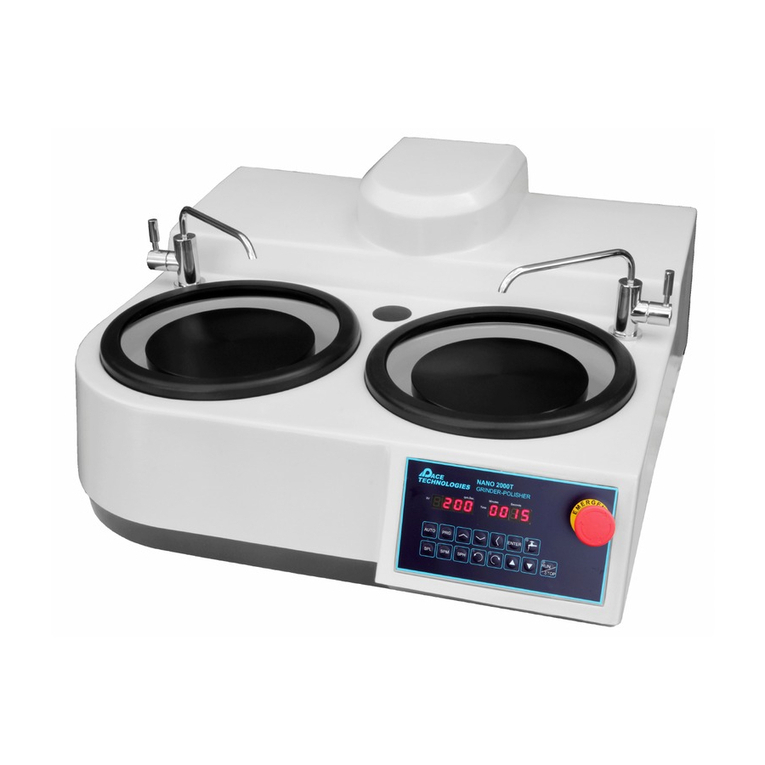
Pace Technologies
Pace Technologies NANO 2000T instruction manual
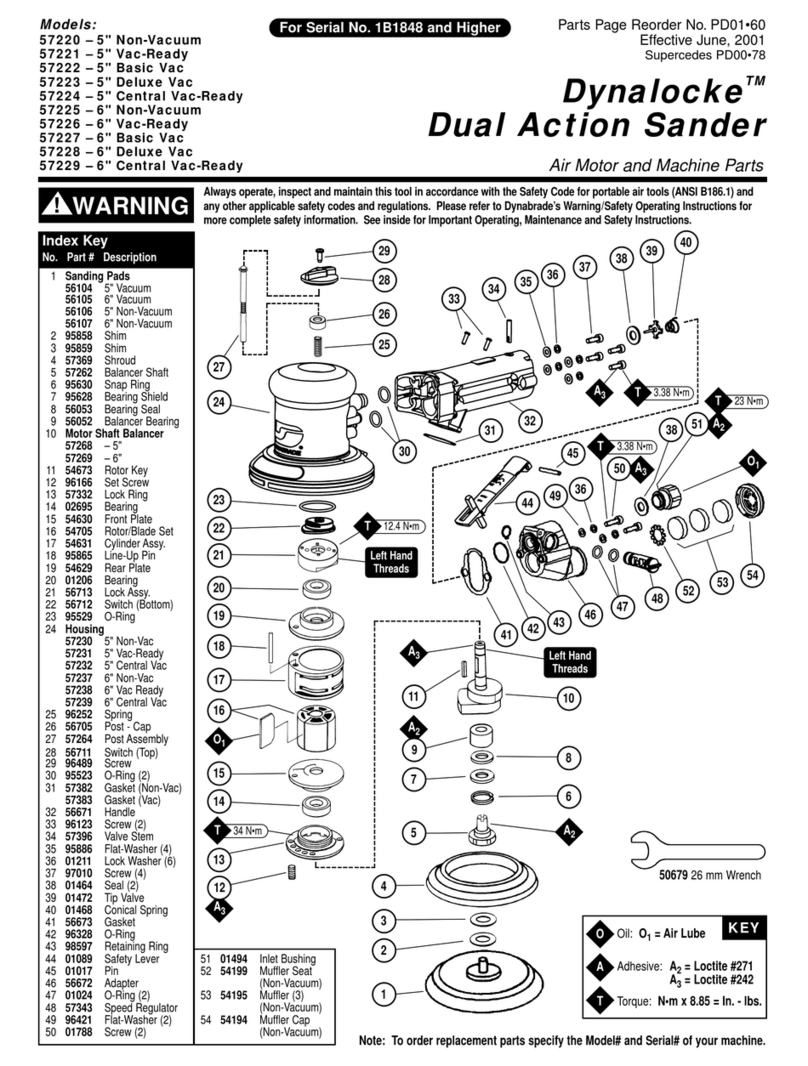
Dynabrade
Dynabrade 57220 Operating, maintenance and safety instructions
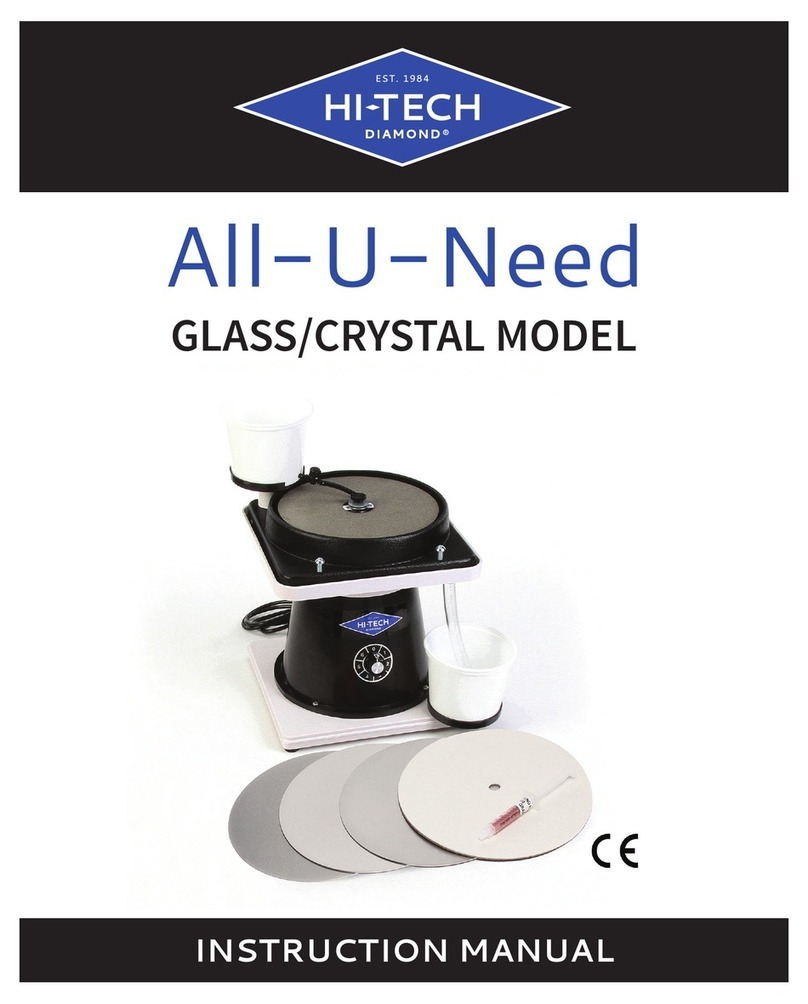
Hitech
Hitech All-U-Need GLASS/CRYSTAL instruction manual

Central Pneumatic
Central Pneumatic Professional 97053 Set up and operating instructions
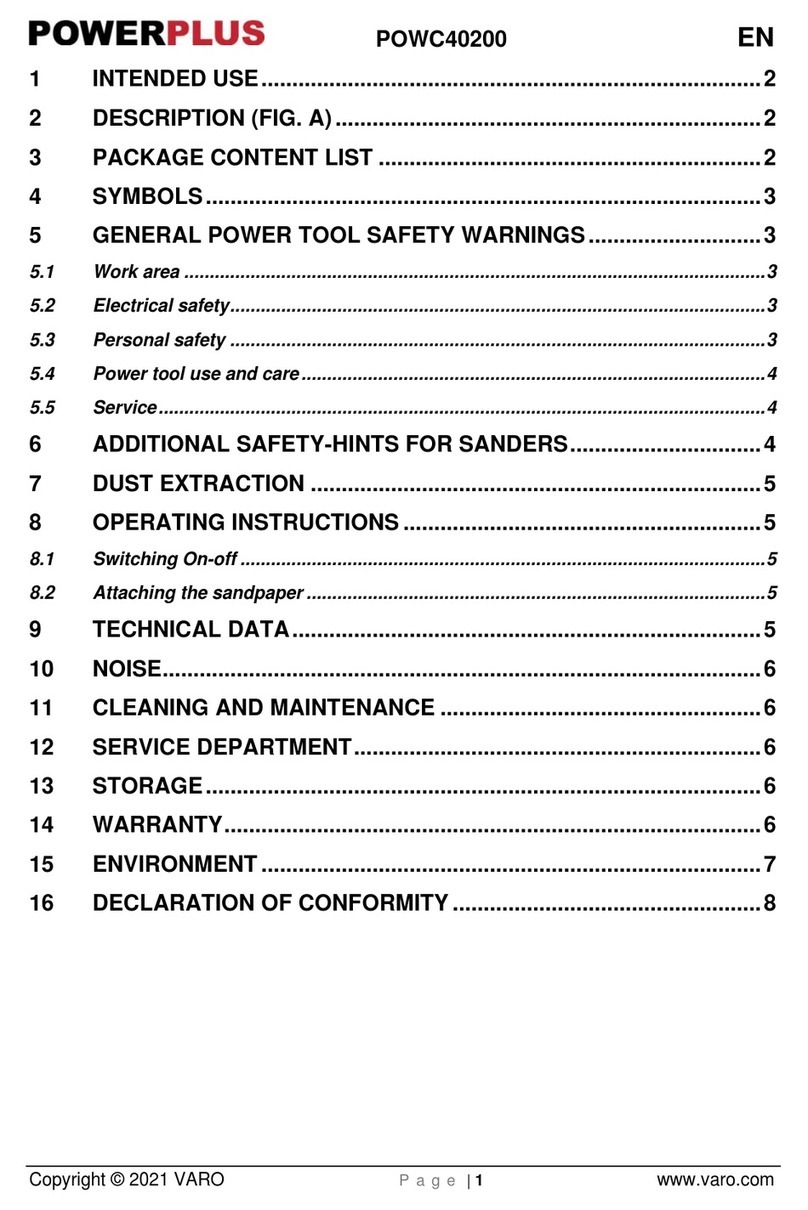
Powerplus
Powerplus POWC40200 manual
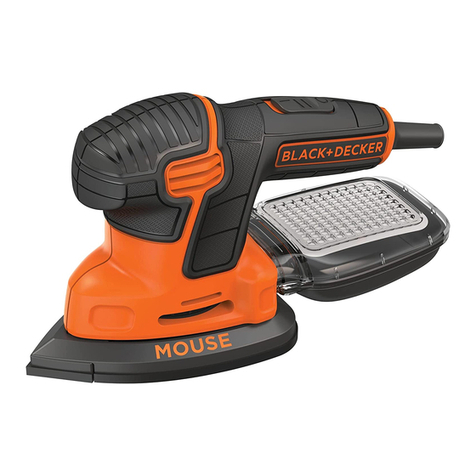
BLACK DECKER
BLACK DECKER KA2000 Original instructions


